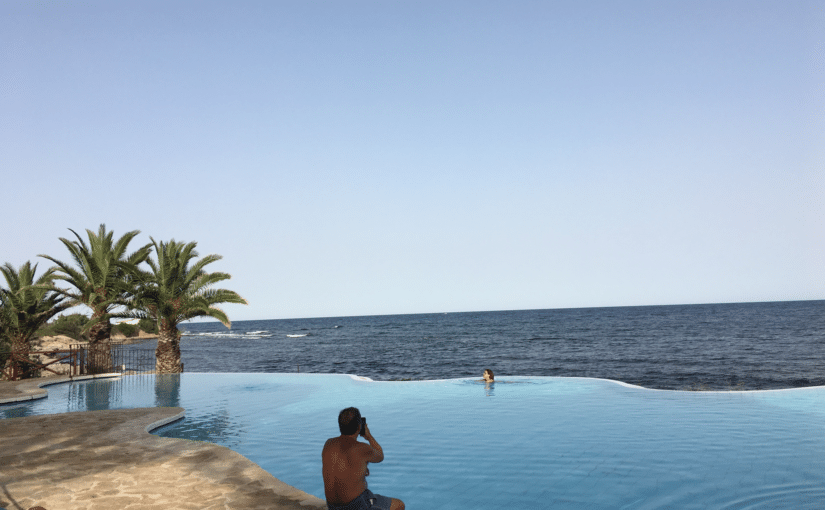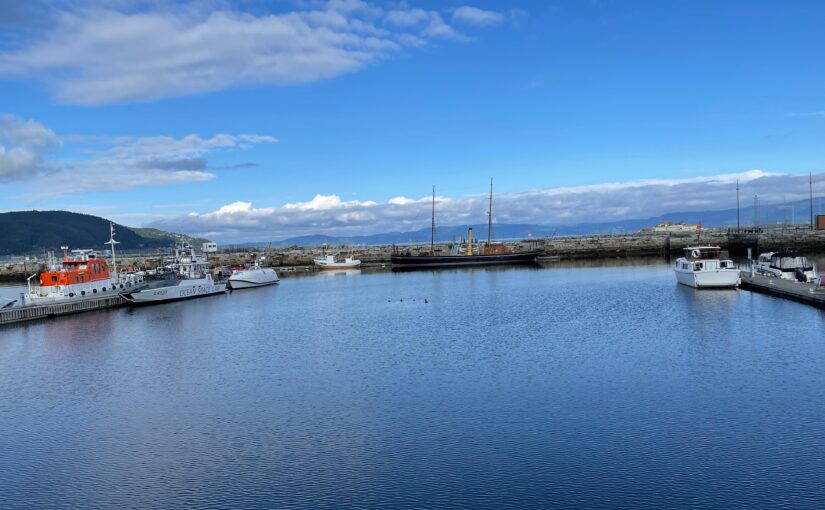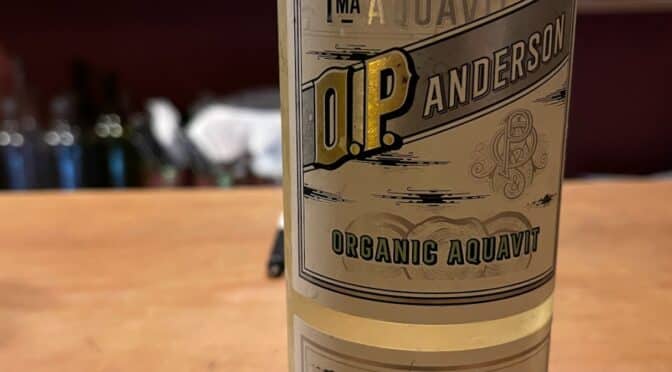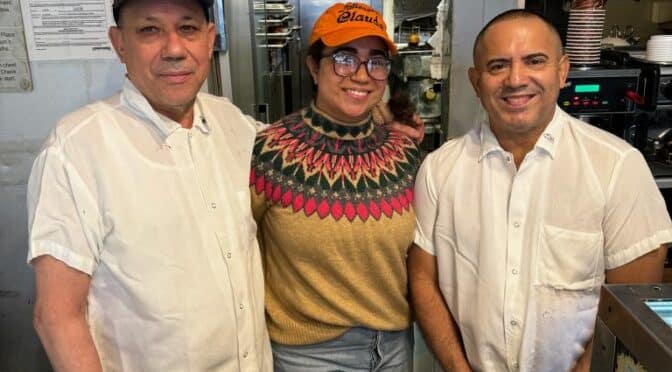by Nick Taylor and Barbara Nevins Taylor
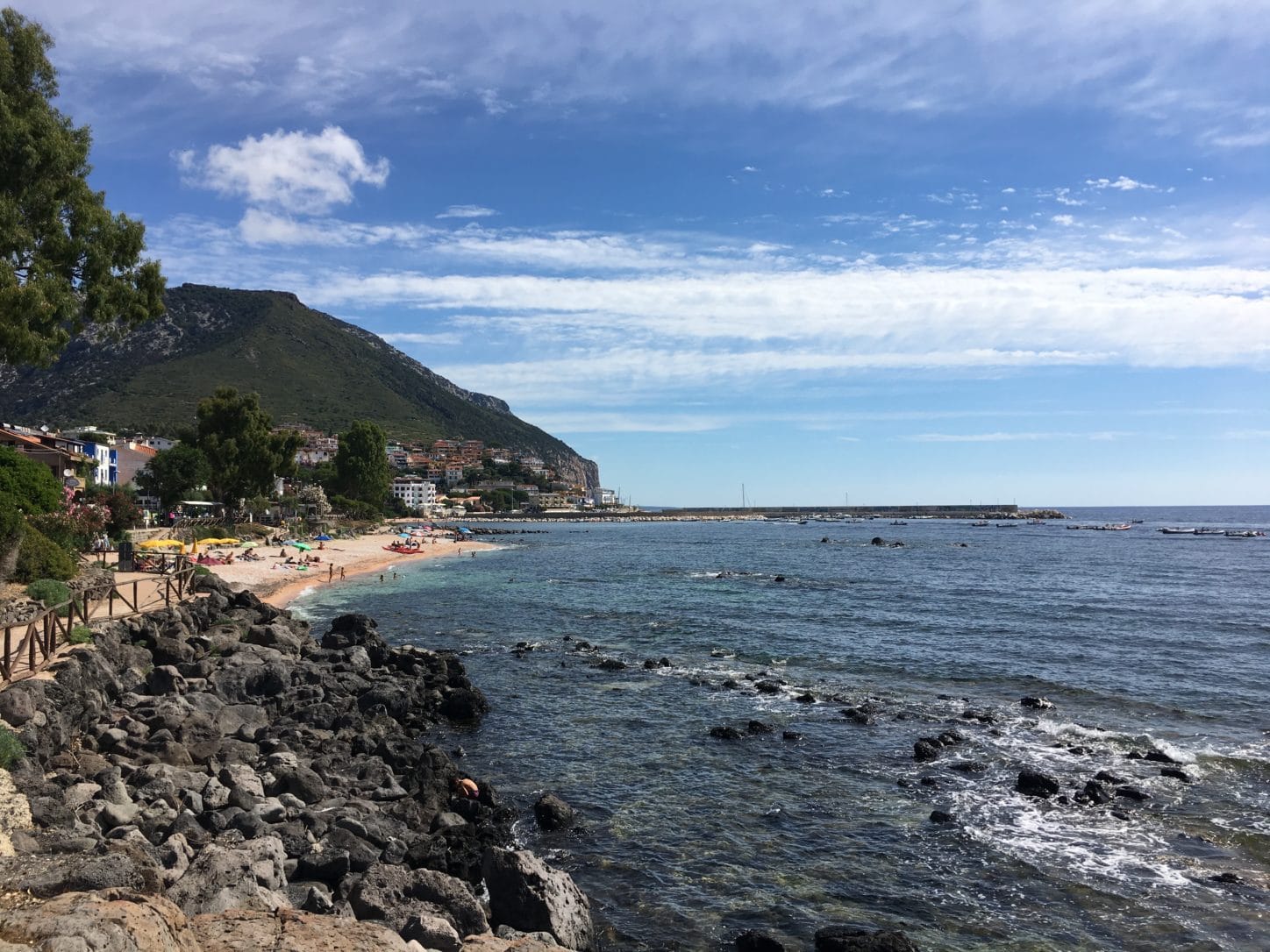
We rated Cala Gonone and La Favorita as one of our five-star stops in Sardinia and we hated to leave. But we had so much more to see. Our love of a good road trip lured us from the sea to the scenic road south to see more of spectacular Sardinia as we headed to Nora and Pula.
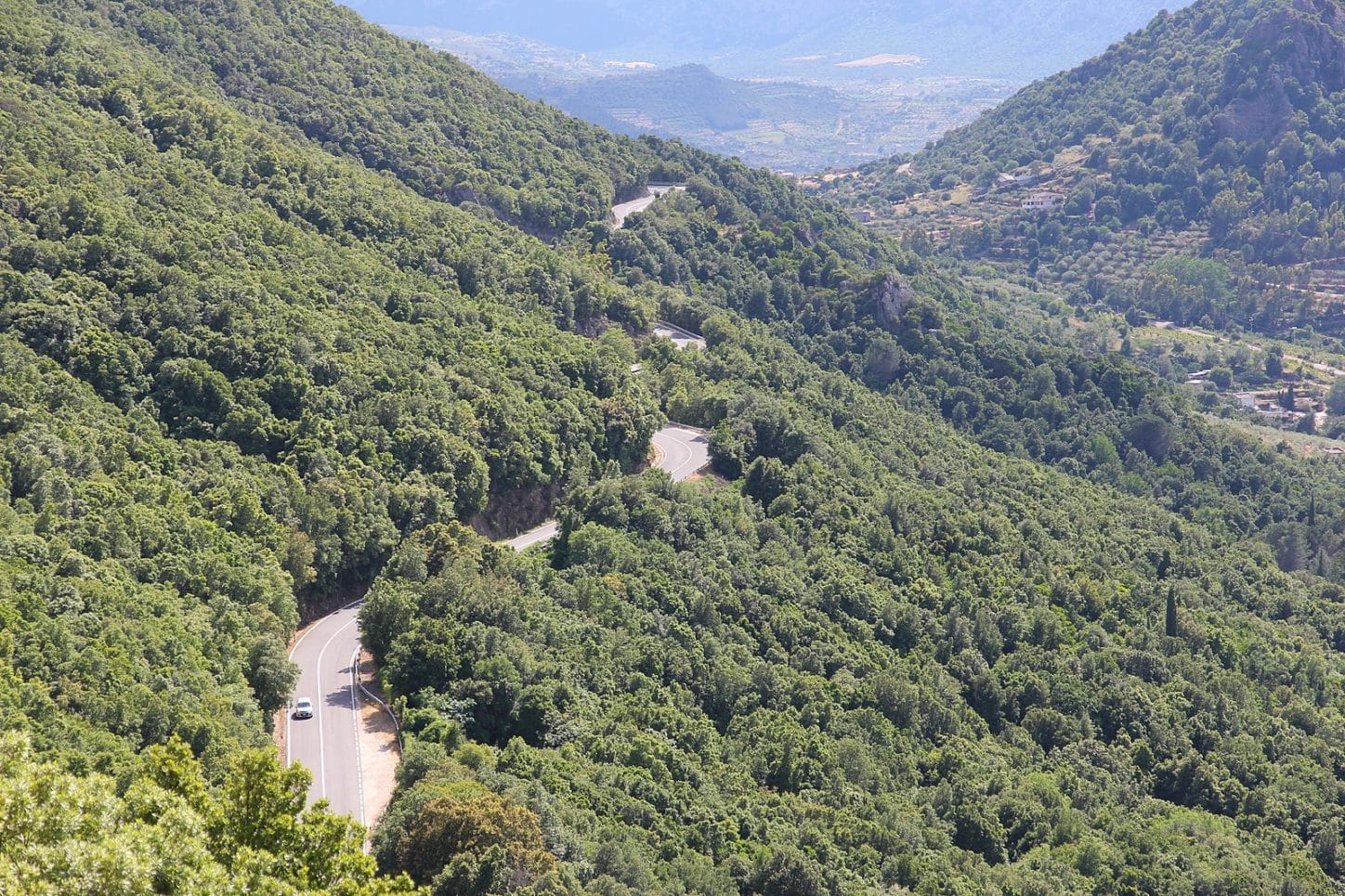
The SS125 runs through the Monti del Gennargentu, the high country covering much of east-central Sardinia. Southbound, it gave us views to the right of sheer rock mountainsides, the Gennargentu National Park, and La Marmora, the island’s highest peak at 1,834 meters.
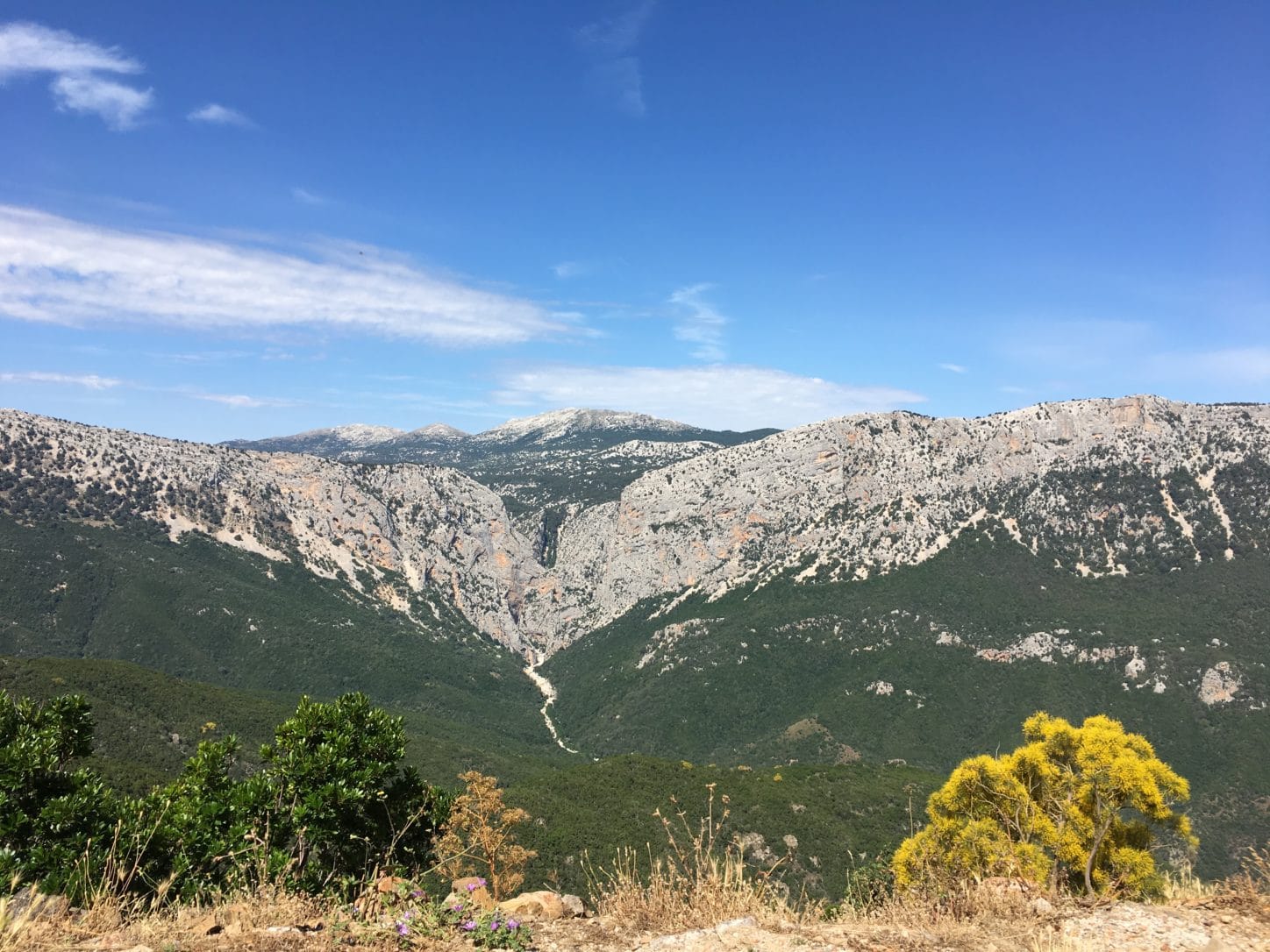
Every turn offered a new vista and we kept our eyes peeled for the next good place to pull over and take photos. It was almost a relief when we emerged from the mountains near Santa Maria Navarrese, where the road flattened and straightened out and gave us better time and few distractions.
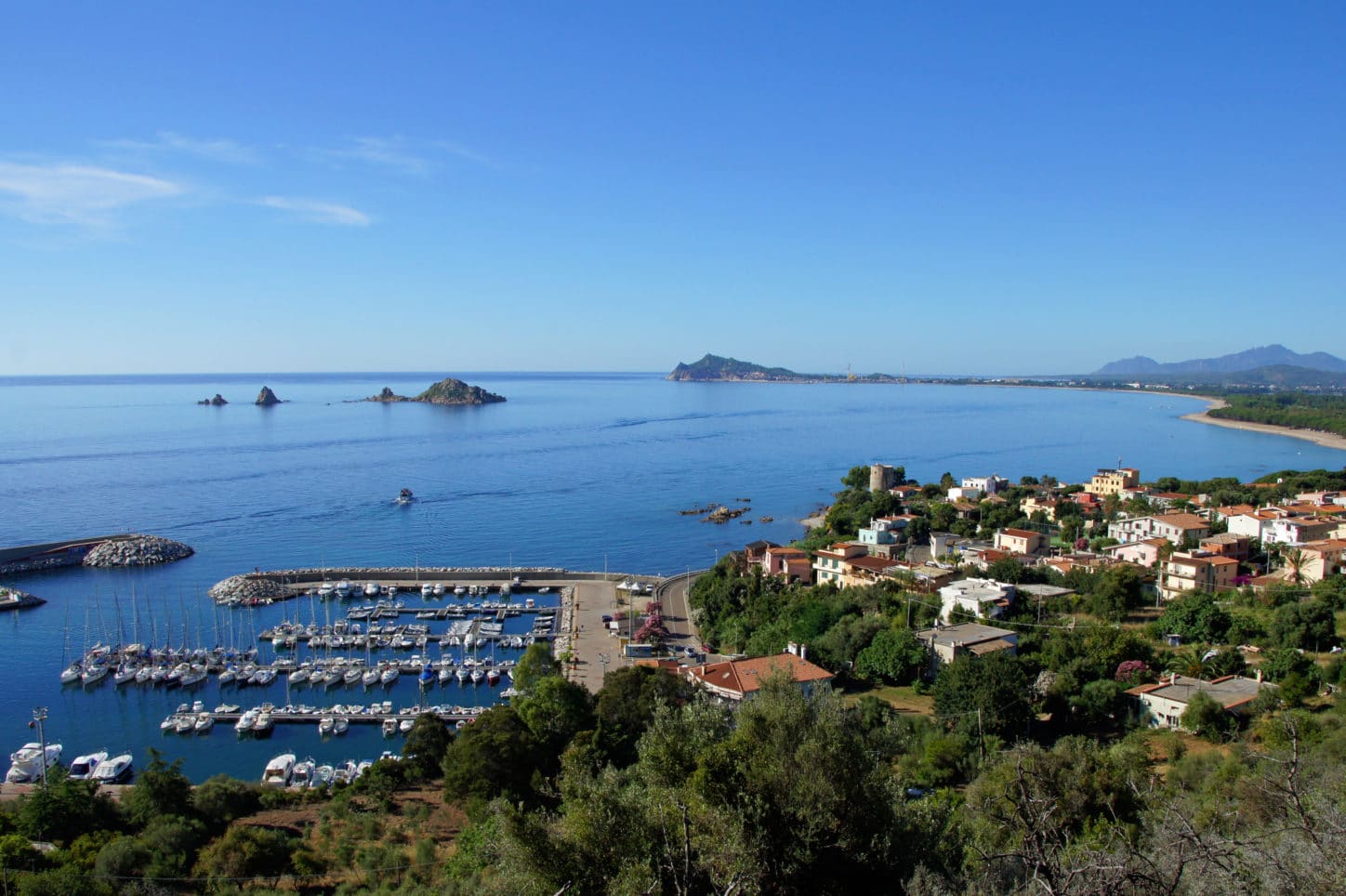
We paralleled the island’s southeast coast past Villaputzu, then turned inland toward Cagliari. From there we’d head south again toward Santa Margherita di Pula and the hotel where we’d spend the last days of our Sardinian holiday.
The GPS, which we were trying to trust again after its bum steer to the giant’s tomb outside Dorgali led us to a pile of rocks, directed us toward Quartu Sant’Elena and Cagliari’s beachfront.
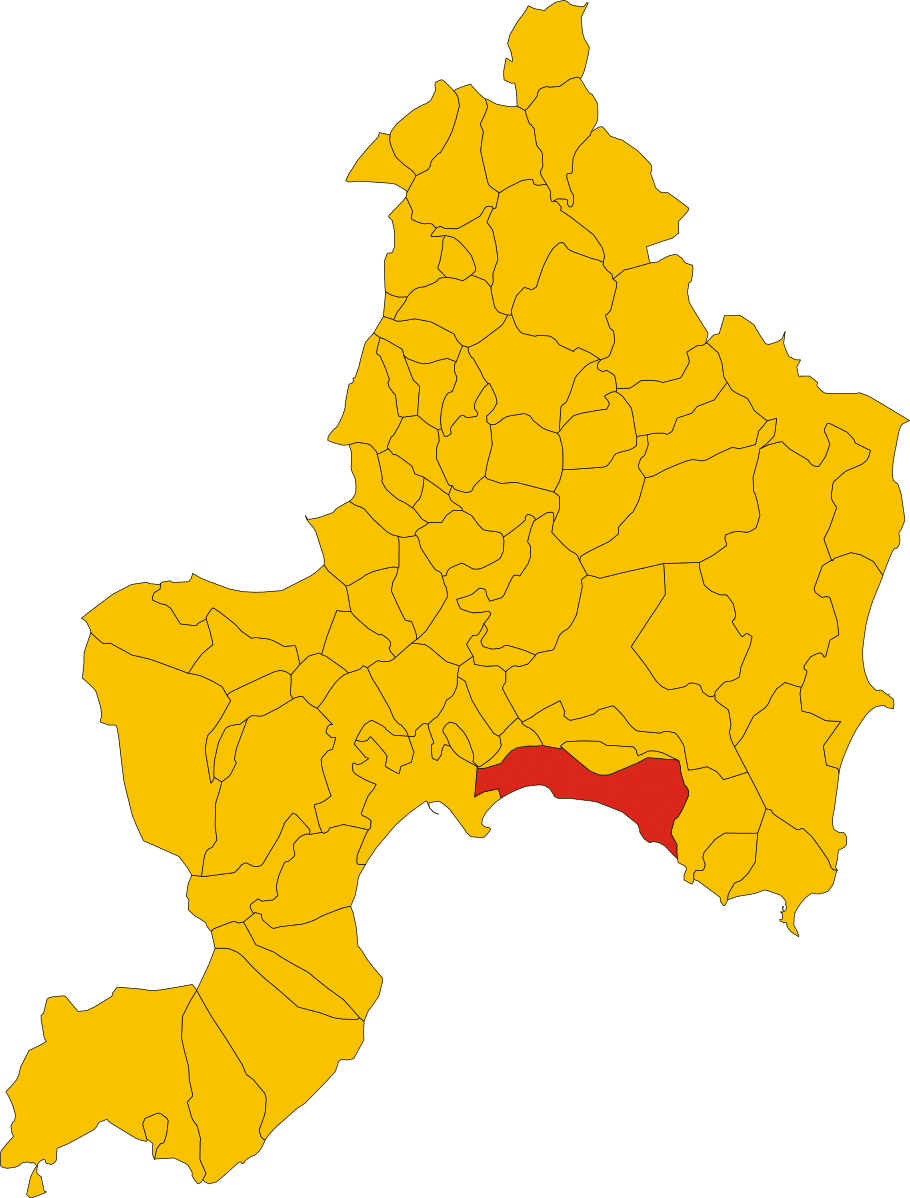
We’d missed this part of Cagliari on our first days in the city. Actually, Quartu Sant’Elena is a separate but adjacent city, Sardinia’s third largest, with some 77,000 people and quite a few flamingos.
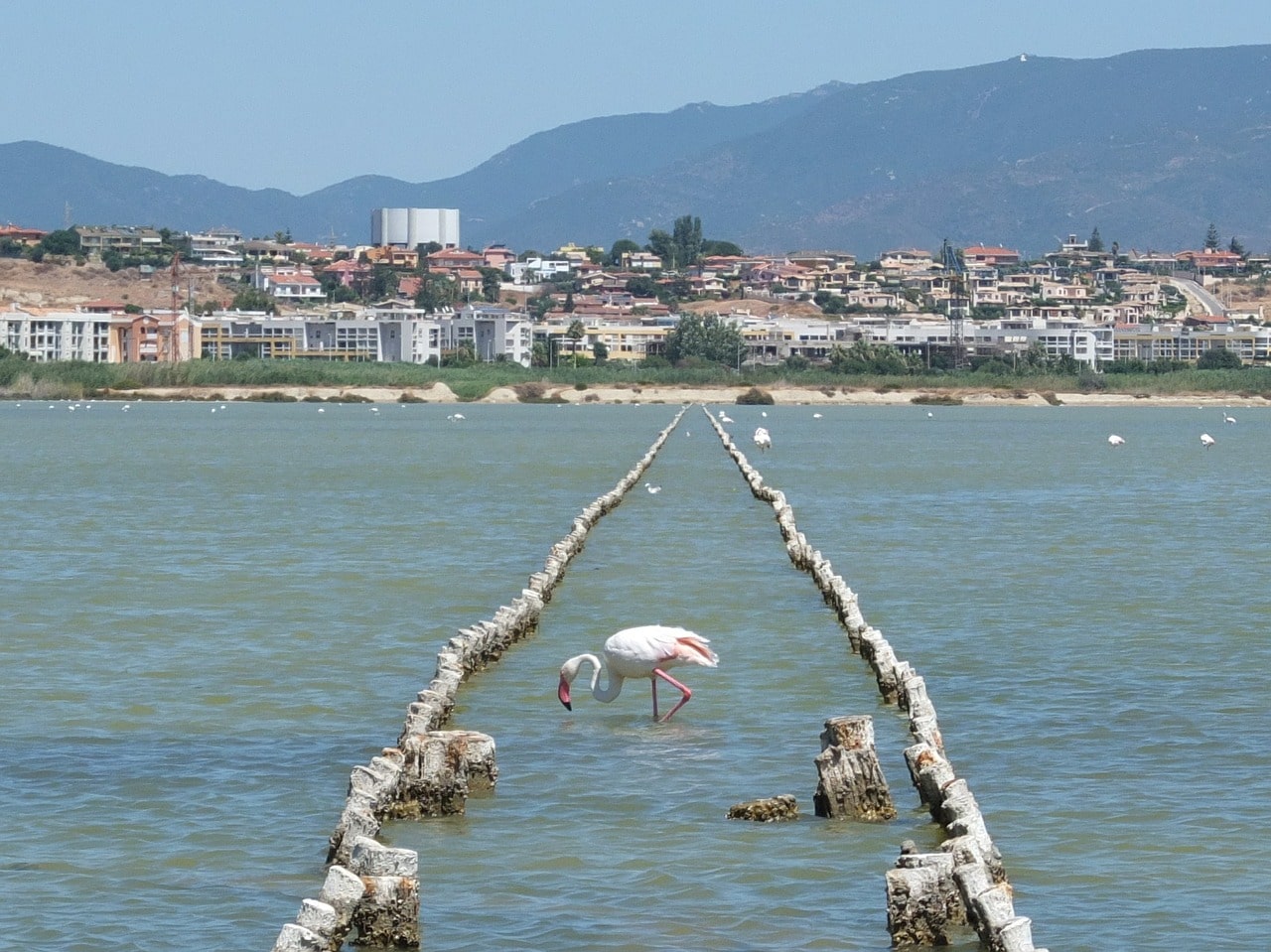
We followed the long crescent of its beach, Spiaggia del Poetto, as we drove, with wide salt flats on the land side to our right.
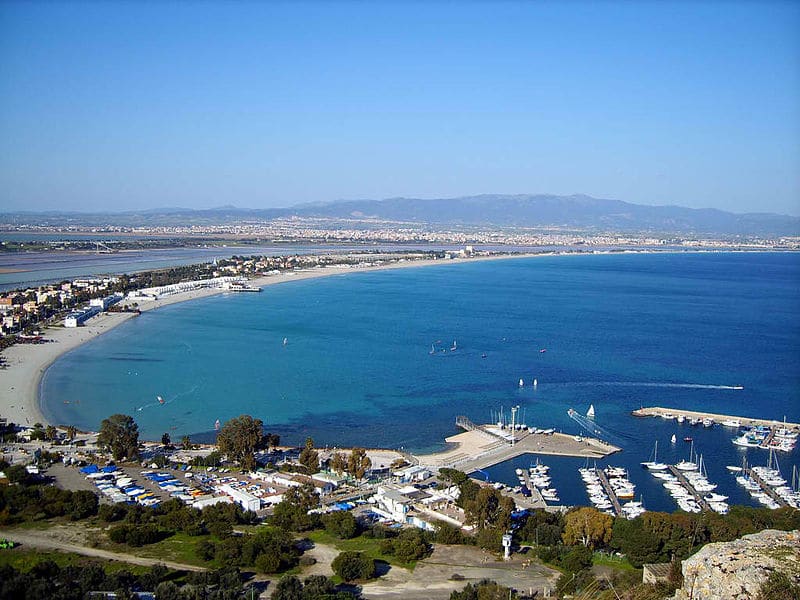
Busy traffic on a Friday afternoon promised a crowded weekend to come. At a roundabout, we turned into the La Marinella restaurant. This sprawling place sat just behind the beach, and we ate a lunch of pasta with clams and bottarga as we admired the invitingly wide stretch of soft sand in front of us.
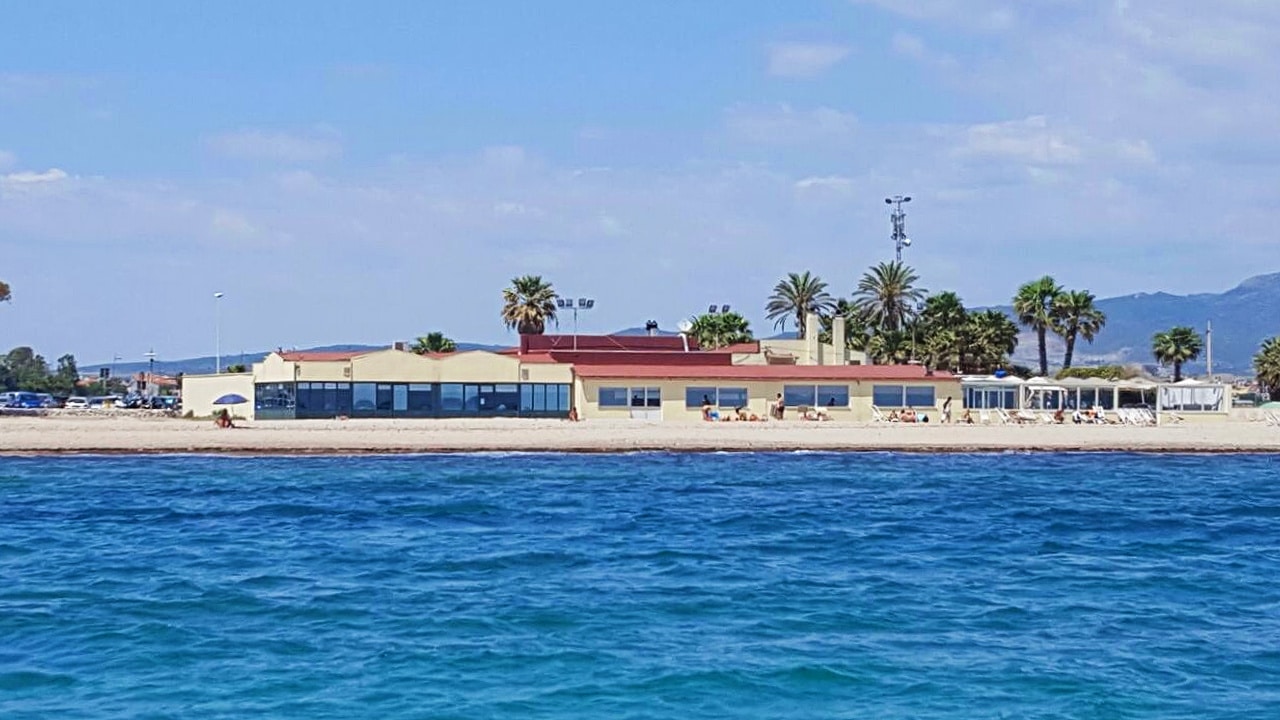
On the way to Cagliari proper, we detoured to take in a city park with saline wetlands that attracted flamingos by the dozens.
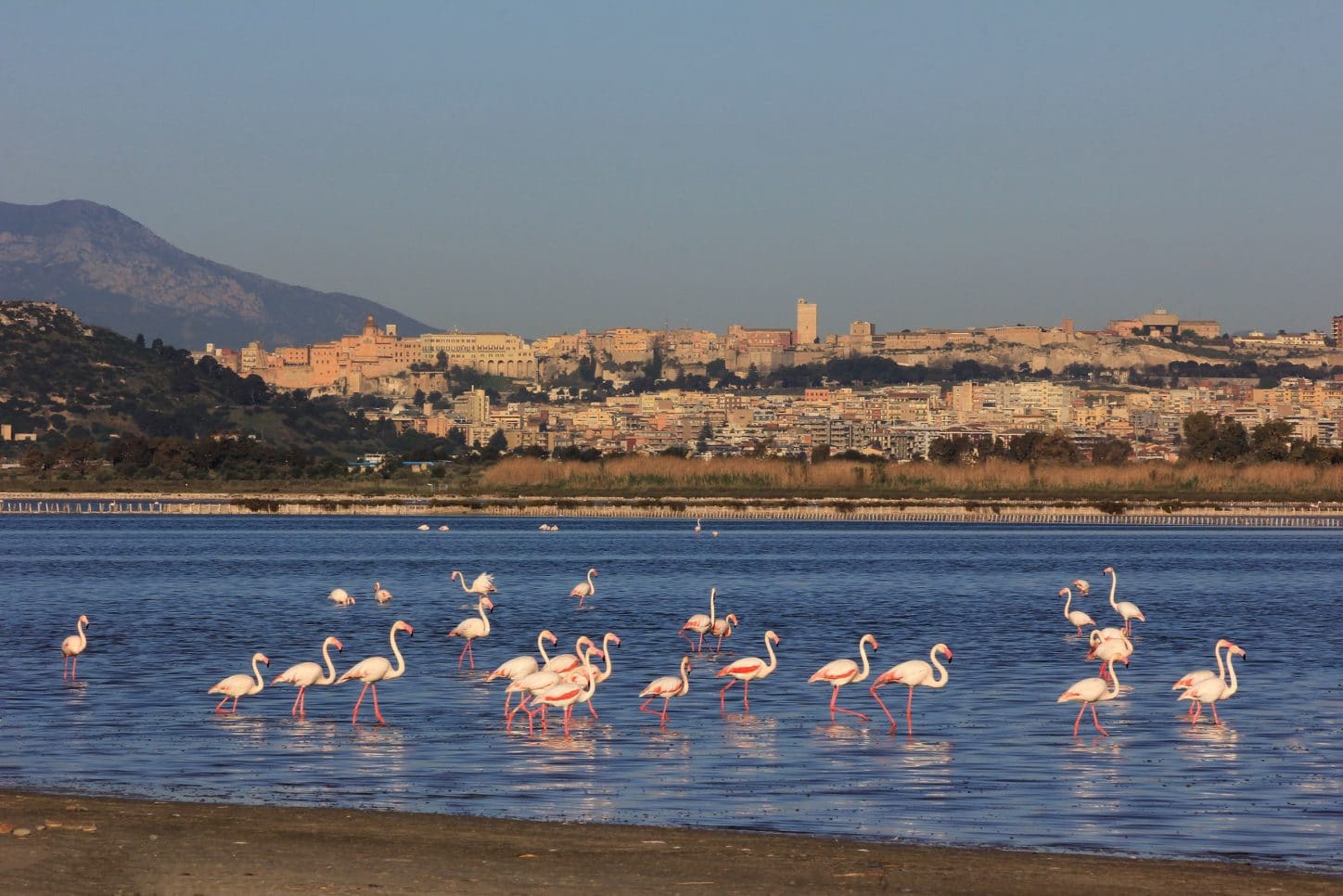
Driving on, we soon entered Cagliari’s familiar Marina District with its pastel houses including the Palazzo Dessy, our first lodging when we reached Sardinia just eight days earlier, rising to our right.
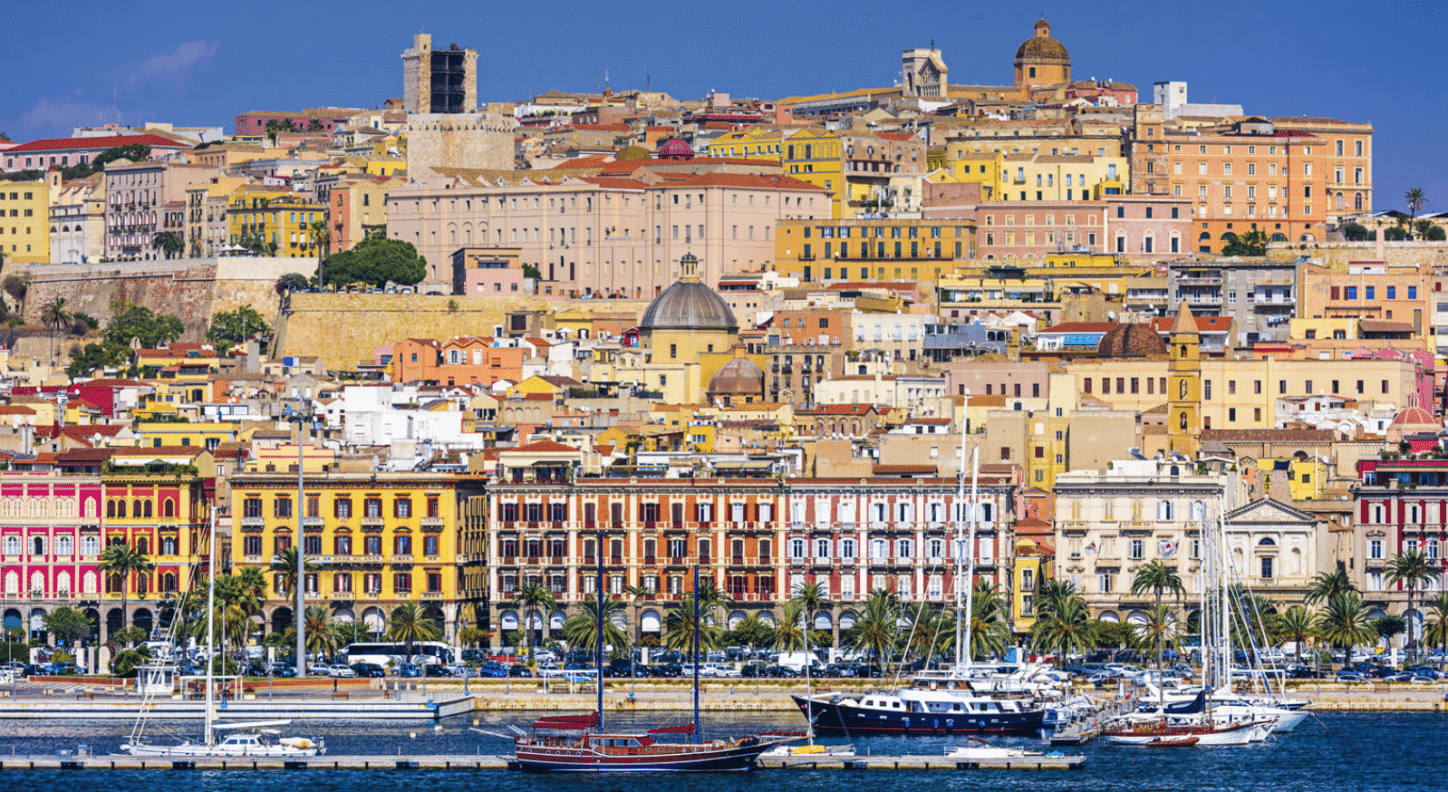
Once we turned south, we hit a series of roundabouts as we passed through small towns near the western shore of the Golfo di Cagliari. Although the rules give cars in the roundabout the right of way, we rarely had to stop. The roundabout is one of the great European inventions. Why we use stoplights almost exclusively in the United States is a traffic-stopping mystery.
We passed Pula and a little below it, just past a Tamoil station, turned left where a small sign told us we’d reached the Costa dei Fiori.
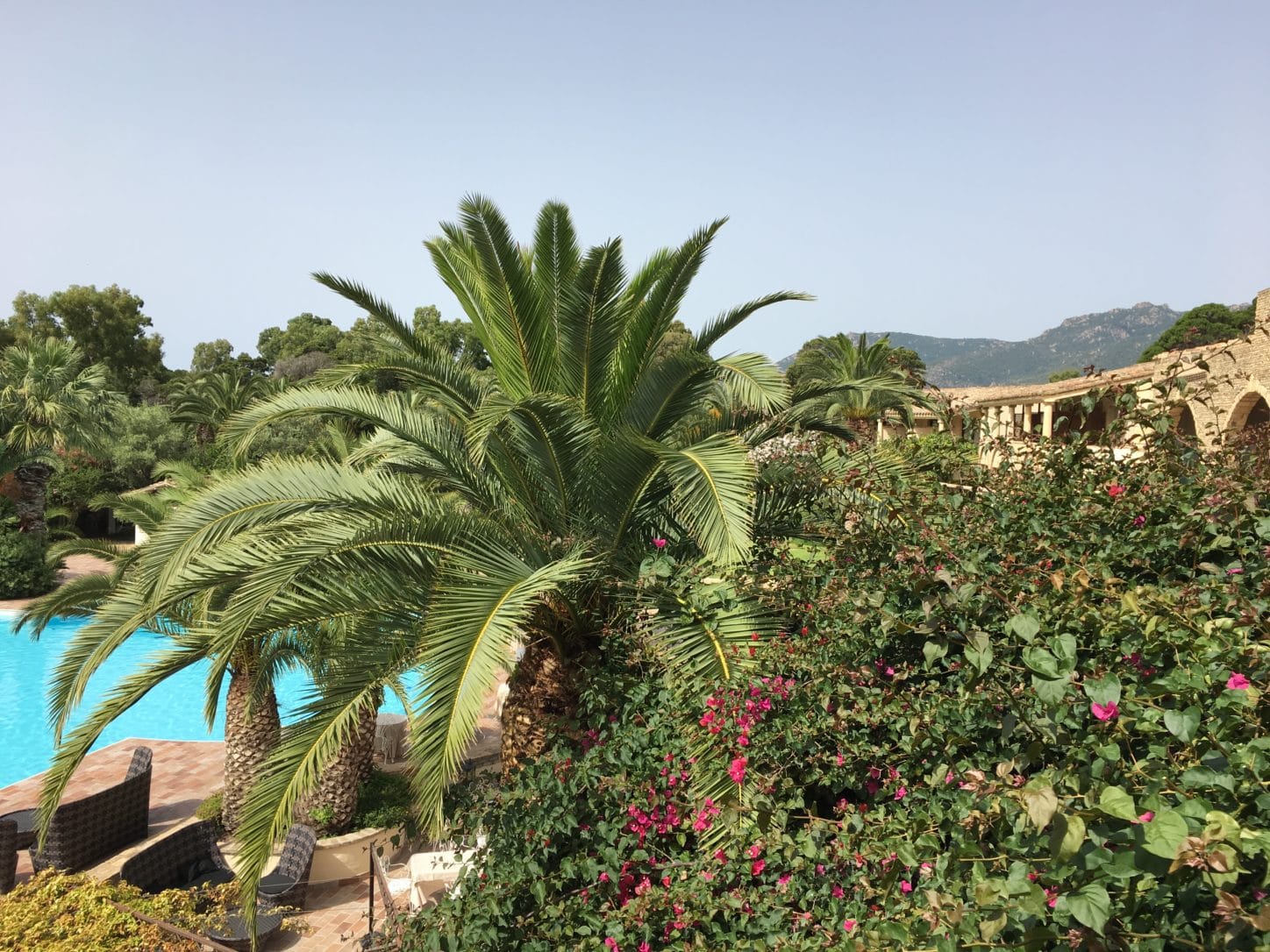
We’d booked this hotel through Booking.com because it was near Nora, Pula and the beach and looked tranquil. We thought we’d need that for our last two island days, after covering two-thirds of Sardinia in just over a week. And indeed, when the dusty dirt road reached the property, beyond a building that looked a little like a La Quinta Inn, we found a manicured compound with green grass and lush palm trees. A large swimming pool with a few lounging sunbathers took center stage.
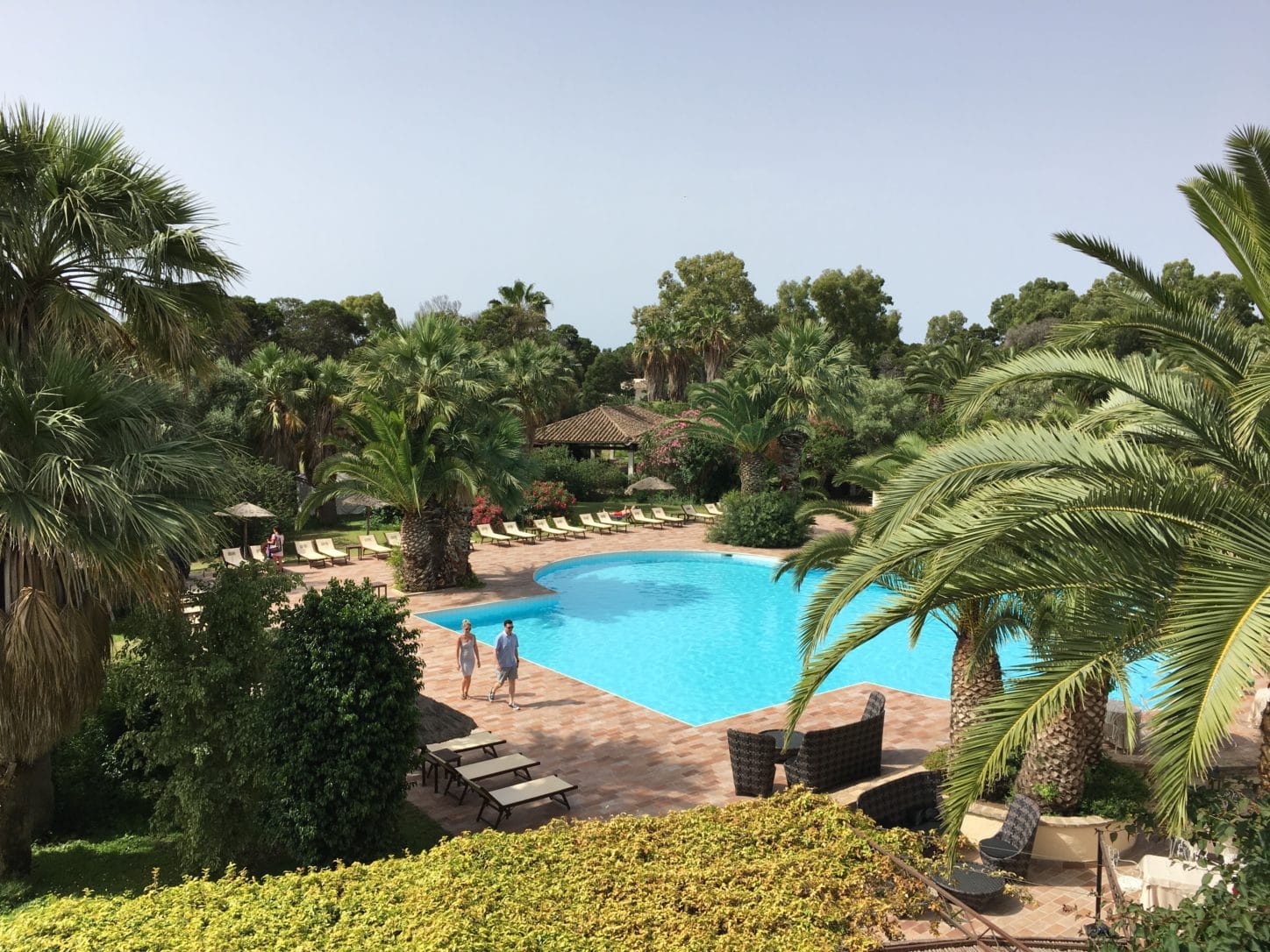
Roberto, the agreeable manager at the reception desk, checked us in. He handed us our room key and then surprised us by immediately telling us we needed to make dinner choices. He walked us around to a corner of the desk, where two menus stood on display. One was the a la carte menu. The second listed the chef’s daily selections. We were eager to get to our room and maybe take a swim, so we told him we’d decide later. He warned us that there were only so many of the daily offerings still unspoken for.
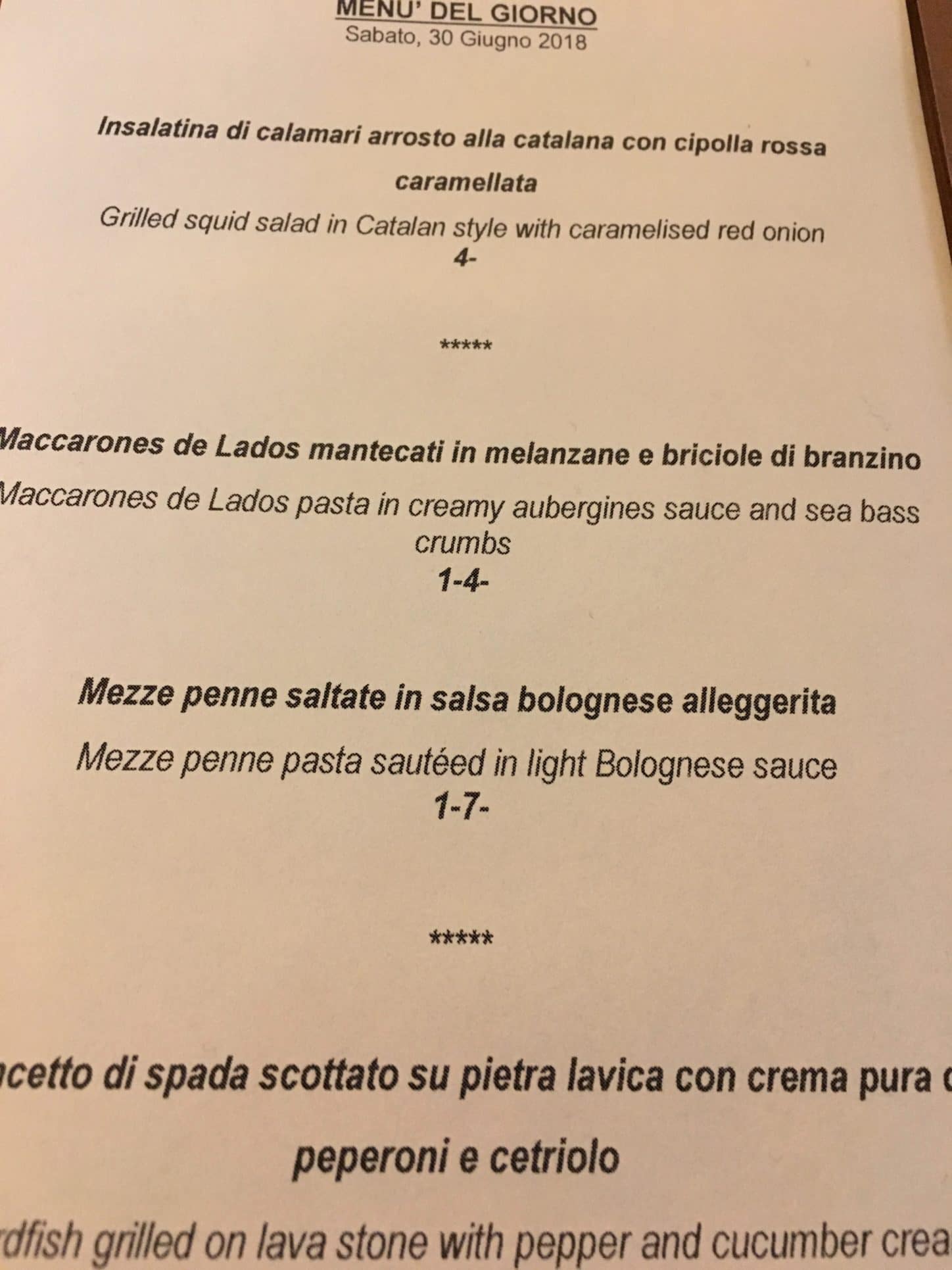
Then, leaving our dinner to the fates, he led us past the swimming pool to our spacious upstairs terrace suite in a wing of the main building, offering rudimentary Italian lessons as we walked. When we got there, our luggage already had arrived.
We put on swimsuits, grabbed towels and our books, and followed a path through the tropical grounds past buildings with more guest rooms to a second swimming pool surrounded by umbrellas and lounge chairs.
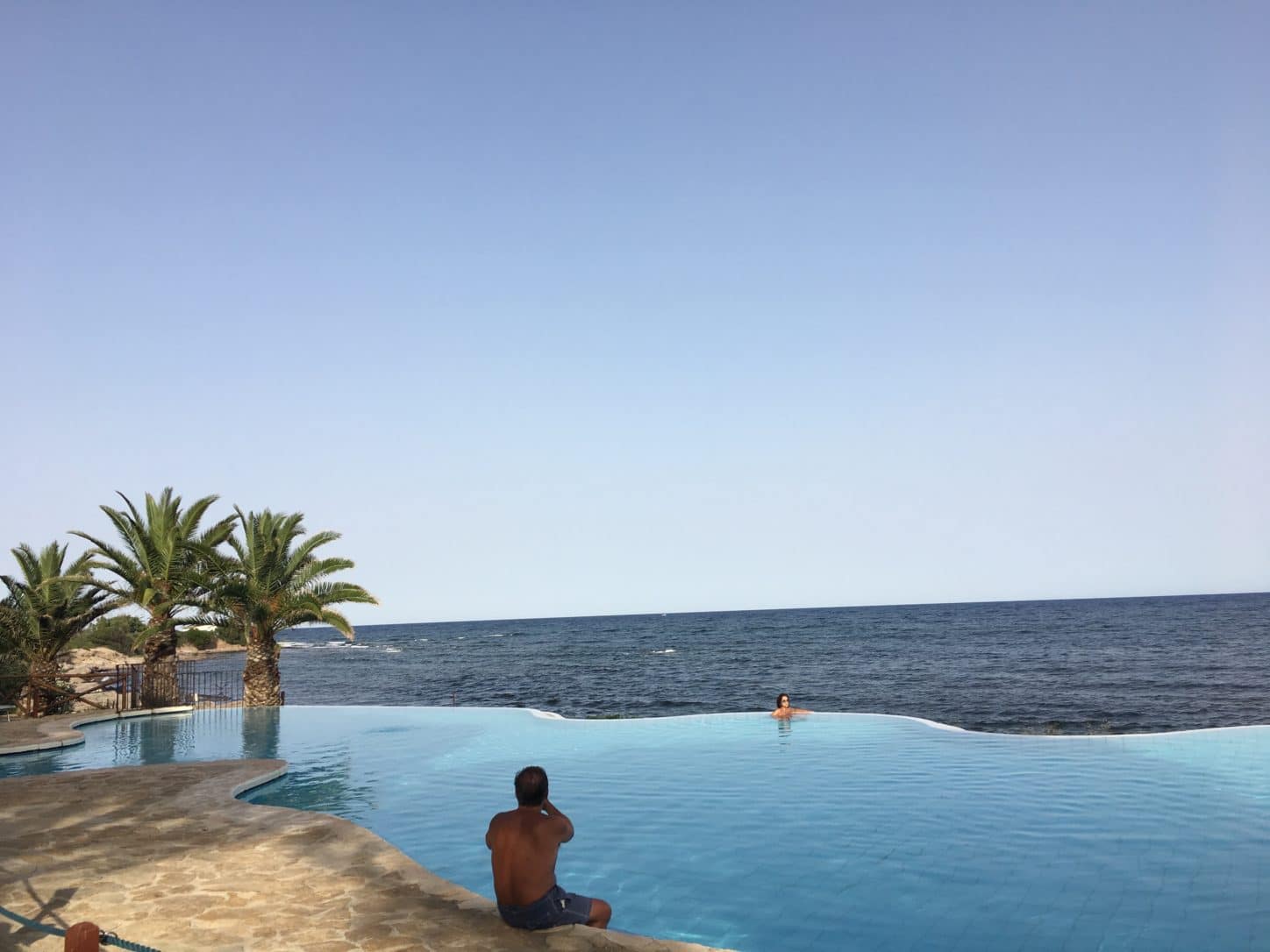
This infinity pool hung on the edge of the sea and seemed almost to be a part of it. We kicked off our flip-flops and swam and floated in its buoyant salt water until the sun beckoned us to dry off and read at a sandy overlook a few steps away.
With all this, we forgot that the clock was ticking on our dinner choices. By the time we opted for the daily menu, the offerings had dwindled to a few.
The a la carte menu looked badly overpriced based on what we’d seen elsewhere, so we made do with what the chef had left from that night’s specials: two courses apiece. Accompanied with one of Sardinia’s fine Vermentinos, they were entirely satisfactory.
As we ate, an Argentinian couple at a nearby table introduced themselves. The woman told us she had visited New York the year before, and had rented an Airbnb apartment in Queens. Something about the owner seemed “a little strange,” she said. She couldn’t put her finger on just why until, when she was about to leave, she found two dead bats squirreled away in a corner of the refrigerator. She and her husband planned to visit New York again, but said they’d stay somewhere else.
The next morning we settled at an outdoor table for breakfast.

We browsed the lavish spread of sliced meats and cheeses, hard-boiled and scrambled eggs, bacon and sausages, juices, fruit, yoghurt and breads set up inside.
A fit couple wearing high-end running and cycling gear sat at the closest table, and we started to talk. John and Mary hailed from Seattle. They had come to Sardinia from Nice, where they celebrated his 60th birthday by competing in an ironman triathlon. Vacations come in all varieties!
Our morning marathon turned out to be finding a parking spot at Nora, an ancient site on the coast halfway to Pula. The parking lined the marsh where, again, we spotted a flamingo or two.
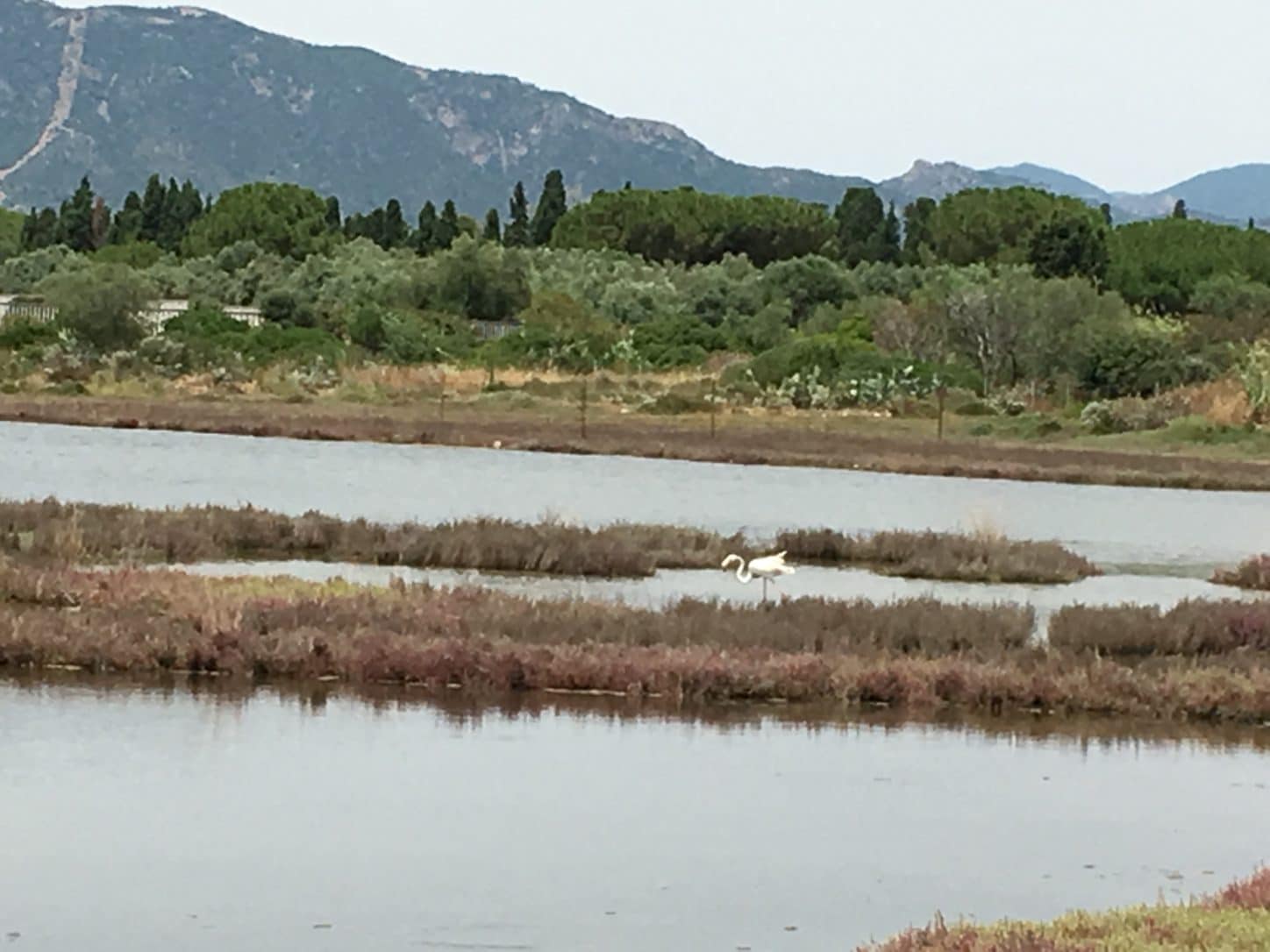 Locals flocking to the beach adjoining Nora and its attractions on a summer Saturday had slammed the parking areas.
Locals flocking to the beach adjoining Nora and its attractions on a summer Saturday had slammed the parking areas.
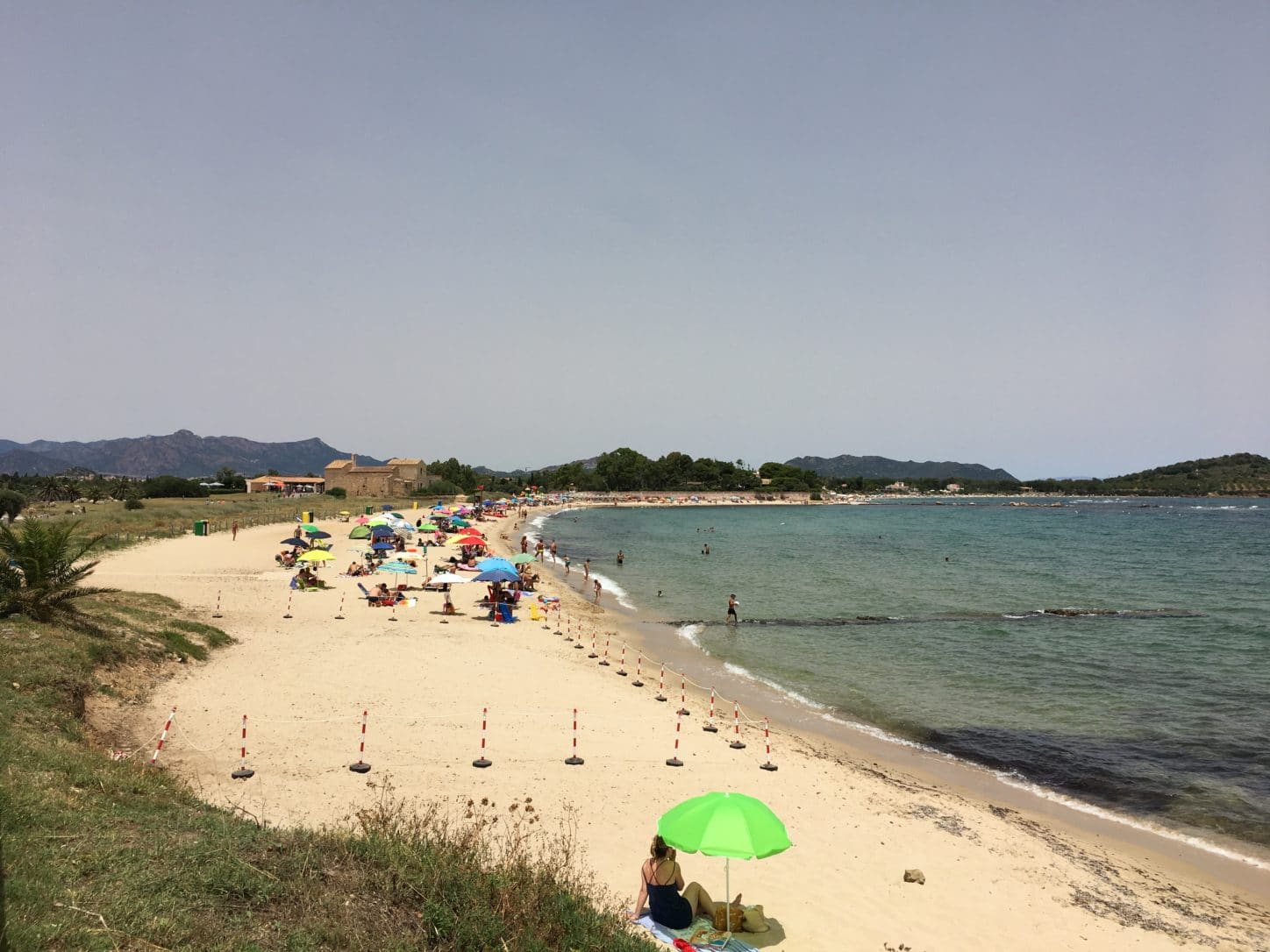
Nora lies largely underwater now, lost to seaside erosion. But enough is left that we could see what the site once meant to the masters of the Mediterranean sea lanes.
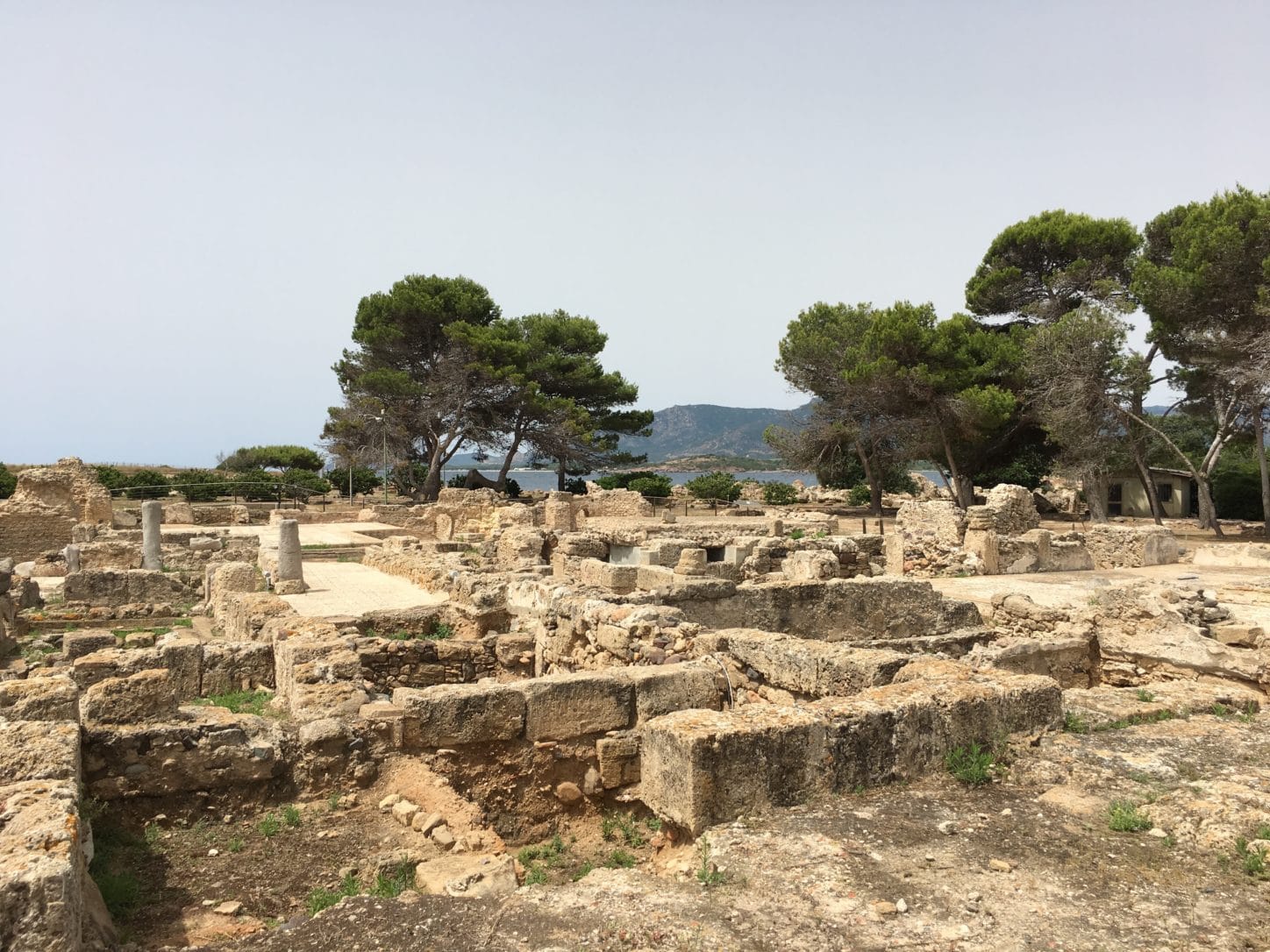
The Phoenicians settled here in the 7th century B.C. Carthaginian conquerers built the town into a commercial and religious center and then the Romans arrived in 238 A.D.

While you can arrange for private tours from guides like Riccardo Mingola, who took us to Barumini when we were in Cagliari, you can also sign up for the local tour. You need a guide to walk around the site and it’s worth it. Nora became one of the standouts of our trip to Sardinia.
Our excellent guide, Illira Lori, led a mixed group who heard her explain Nora’s history, first in Italian and then English.
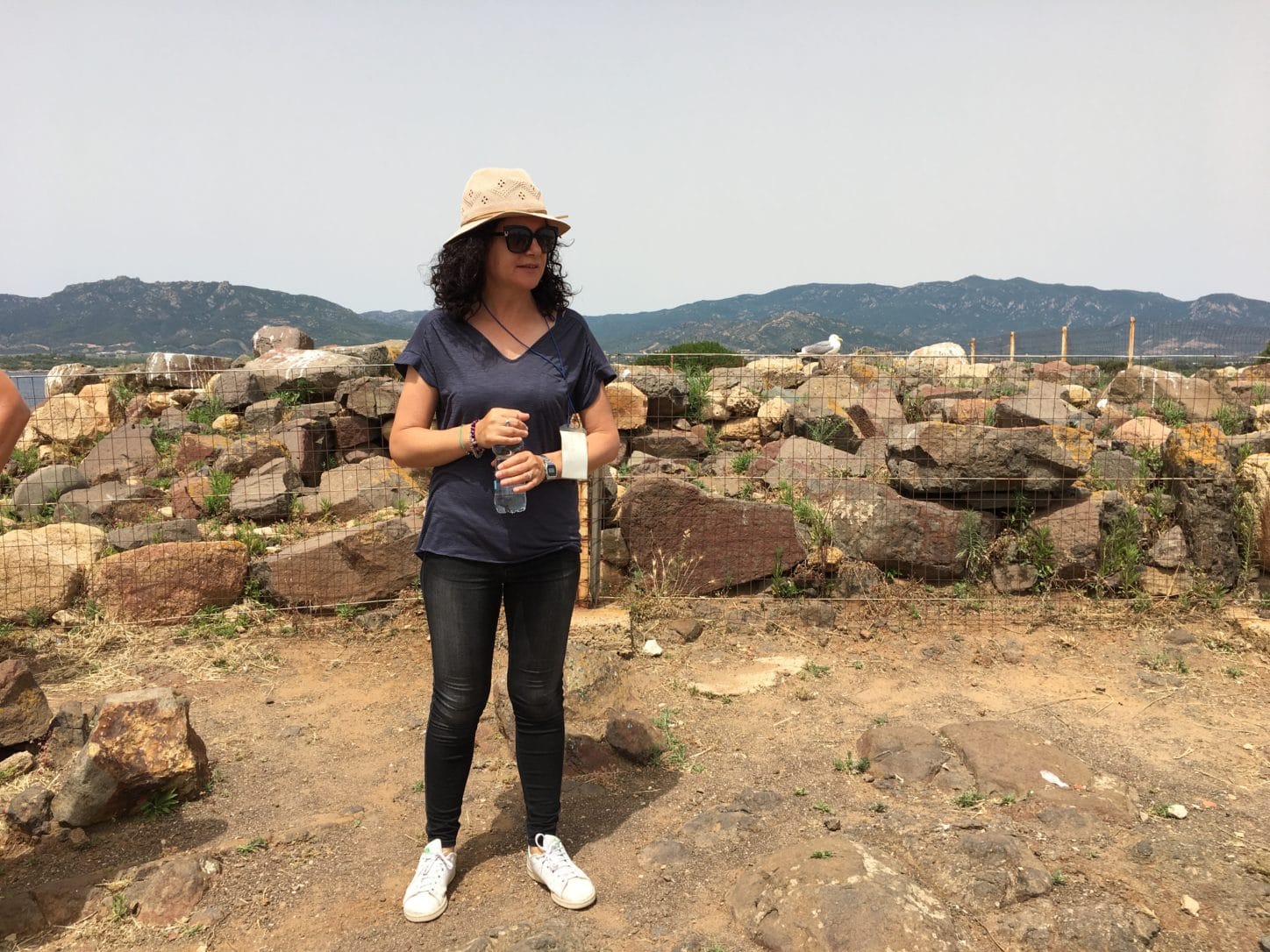
She told us that excavation began in 1952, when archeologists discovered a Roman amphitheater that is still in use today. Workers were setting up for a concert when we were there.
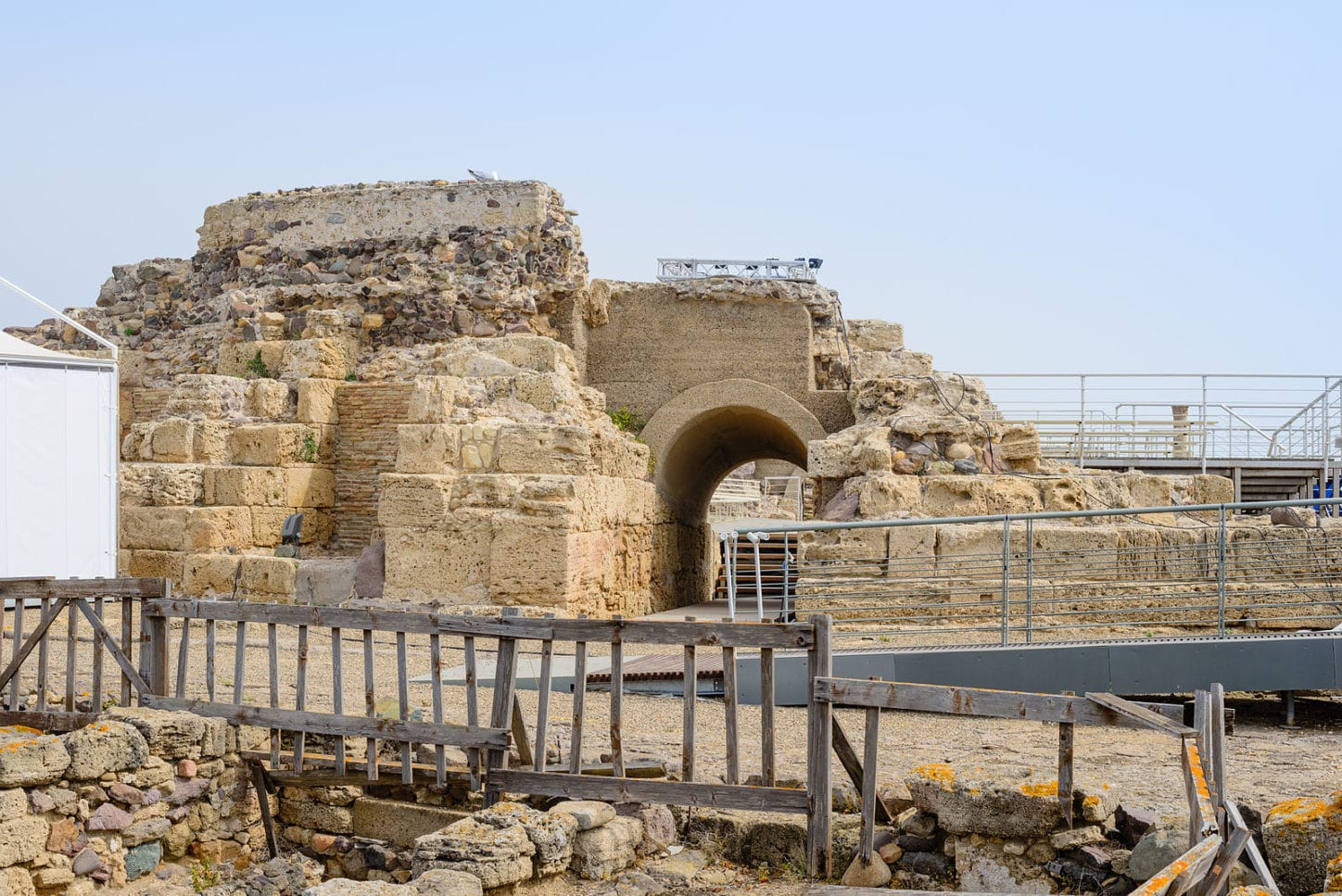
Small details fascinated us, like the way the Romans laid the brick wall behind the amphitheater.
 Over the years, teams from the University of Genoa and the University of Cagliari unearthed the city and learned how people in the stratified Roman society lived.
Over the years, teams from the University of Genoa and the University of Cagliari unearthed the city and learned how people in the stratified Roman society lived.
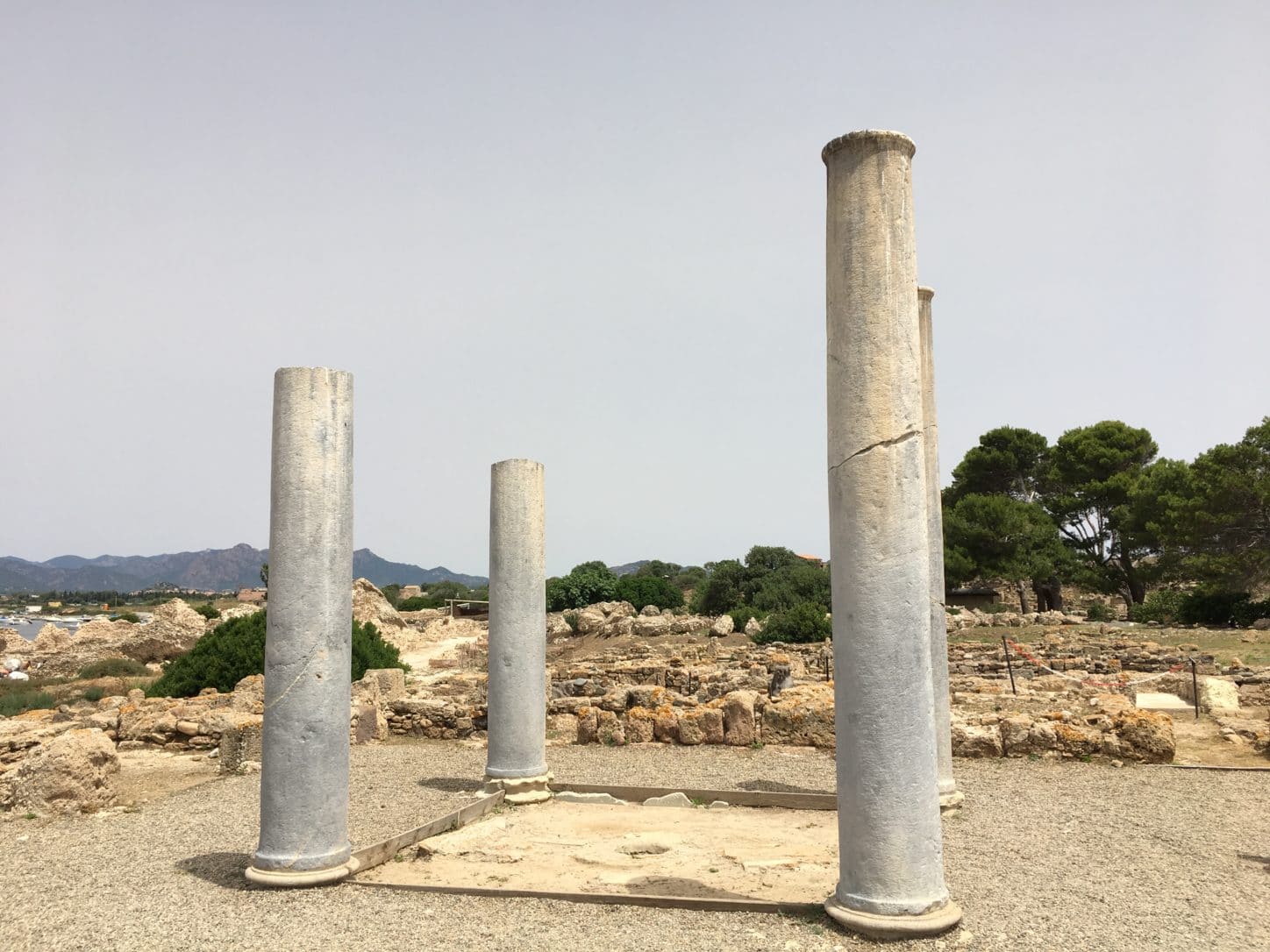
The rich lived uphill, in homes with columns away from the shoreline close to what is now the bay side. The mosaics in the homes of the wealthy featured finer stones and more intricate patterns. The one below seems to feature a nymph.
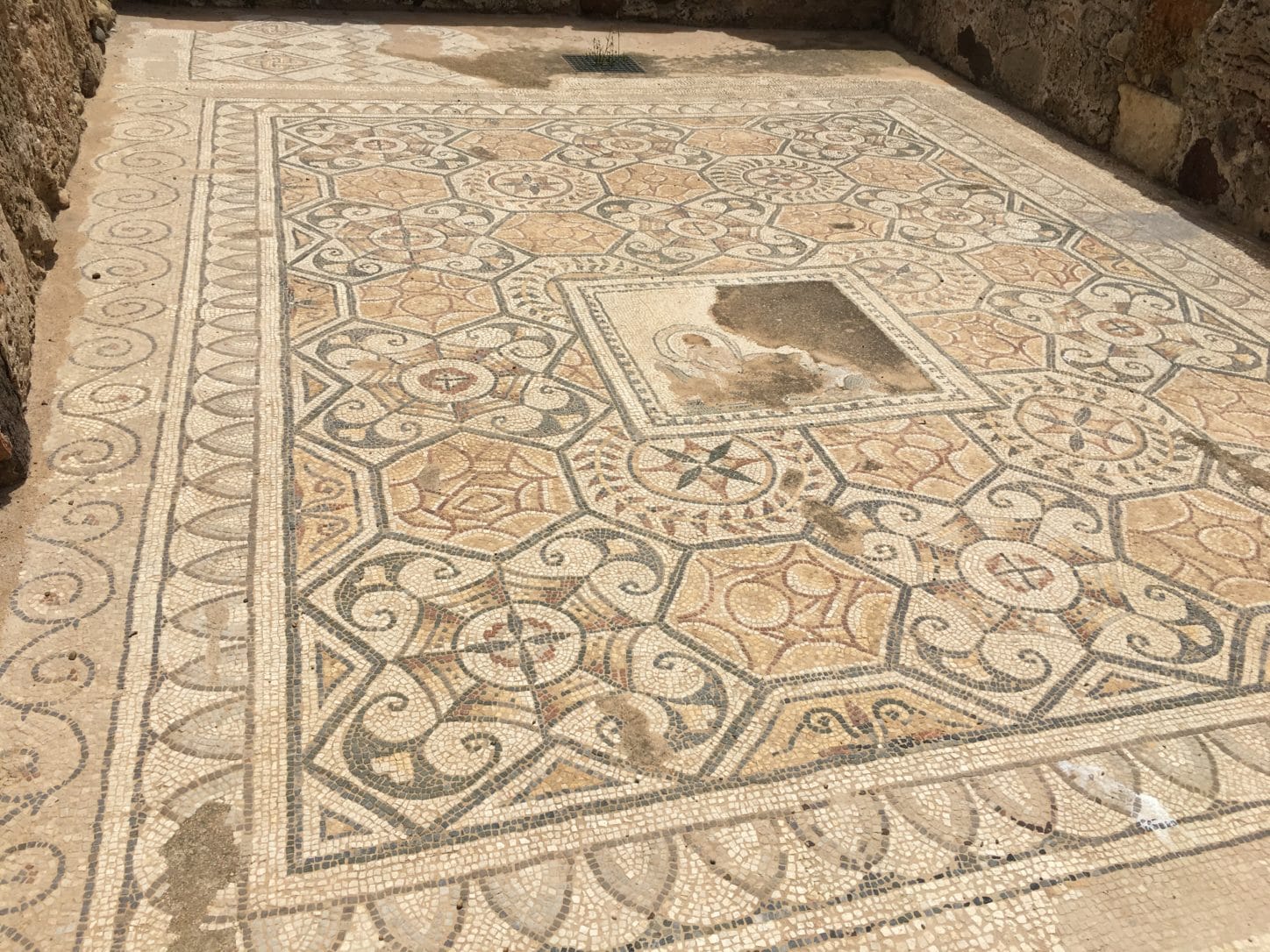
But in the common areas, like the forum, the mosaic stones are larger and the patterns less intricate.

Archeologists unearthed enough of the communal bath to determine that there was a series of cold and hot baths ranging from 44 degrees centigrade, or 110 degrees farenheit, to very cold. The limestone roof had collapsed at some point, creating a weird canopy.
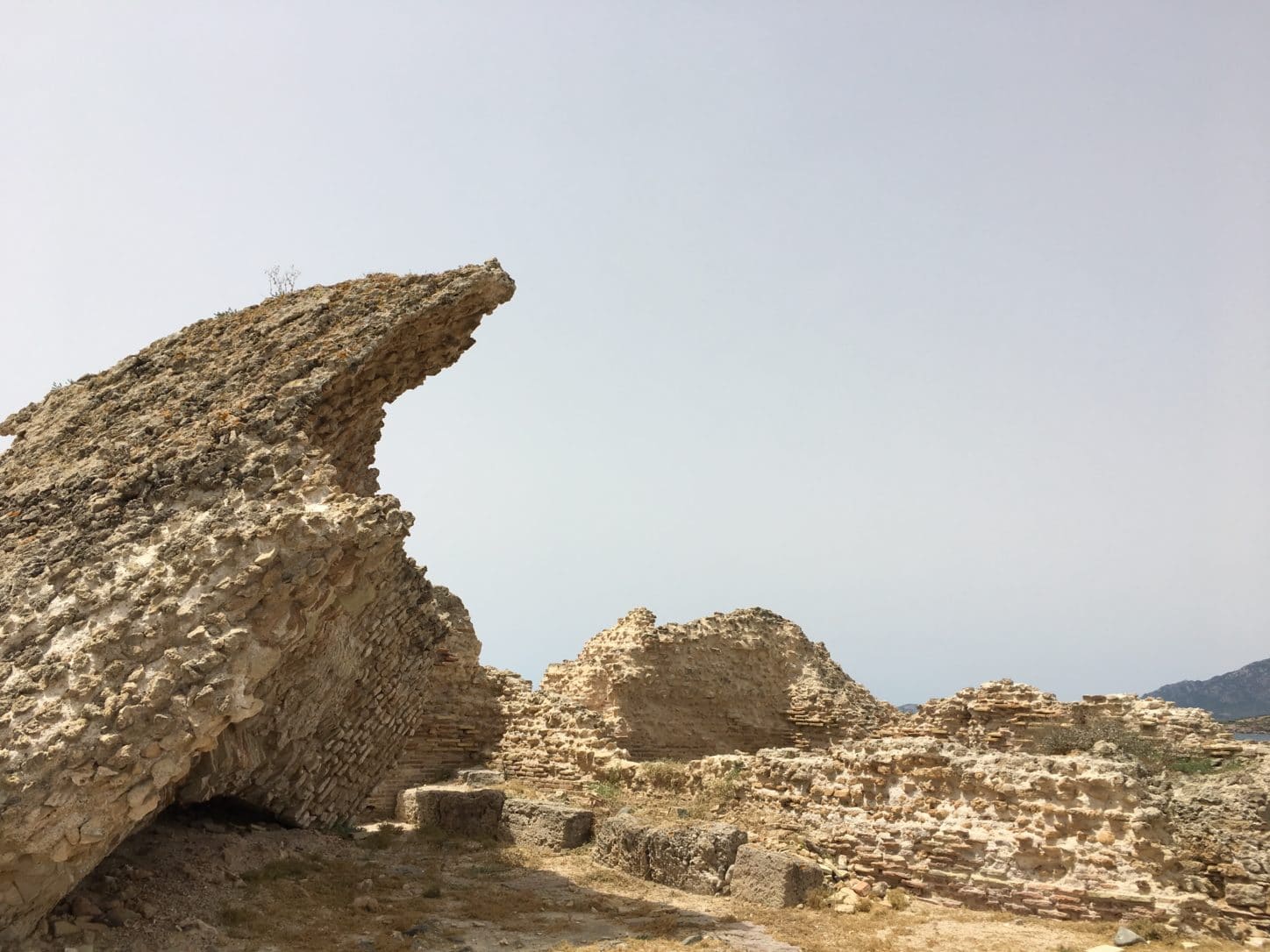
Closer to the shoreline, we saw what appeared to be the communal cooking area. With our guide Illira’s help, we could make out what was a water jug snugged in the ground.
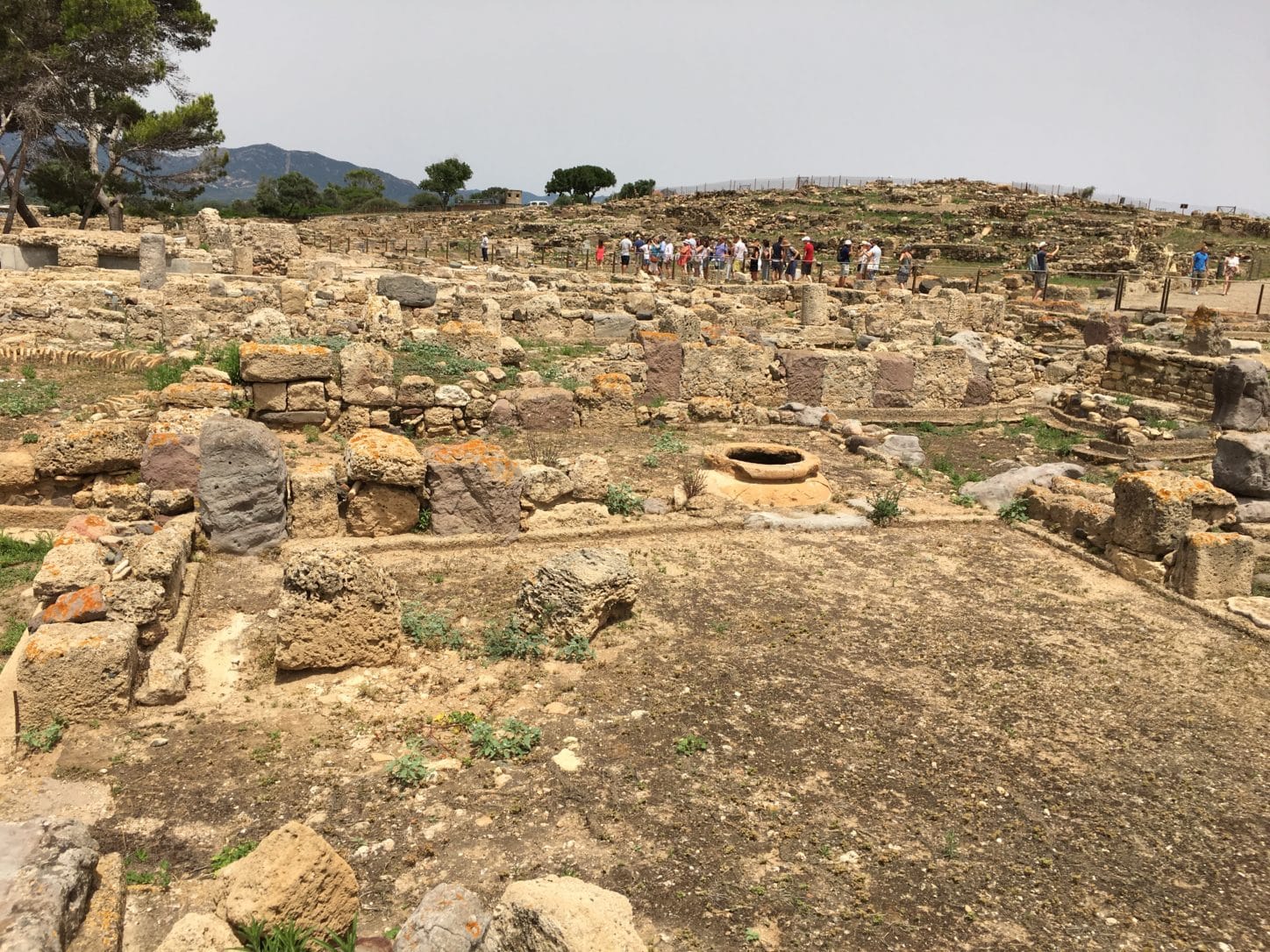
A few feet away, she pointed out a jug that she said was the top of a millstone.
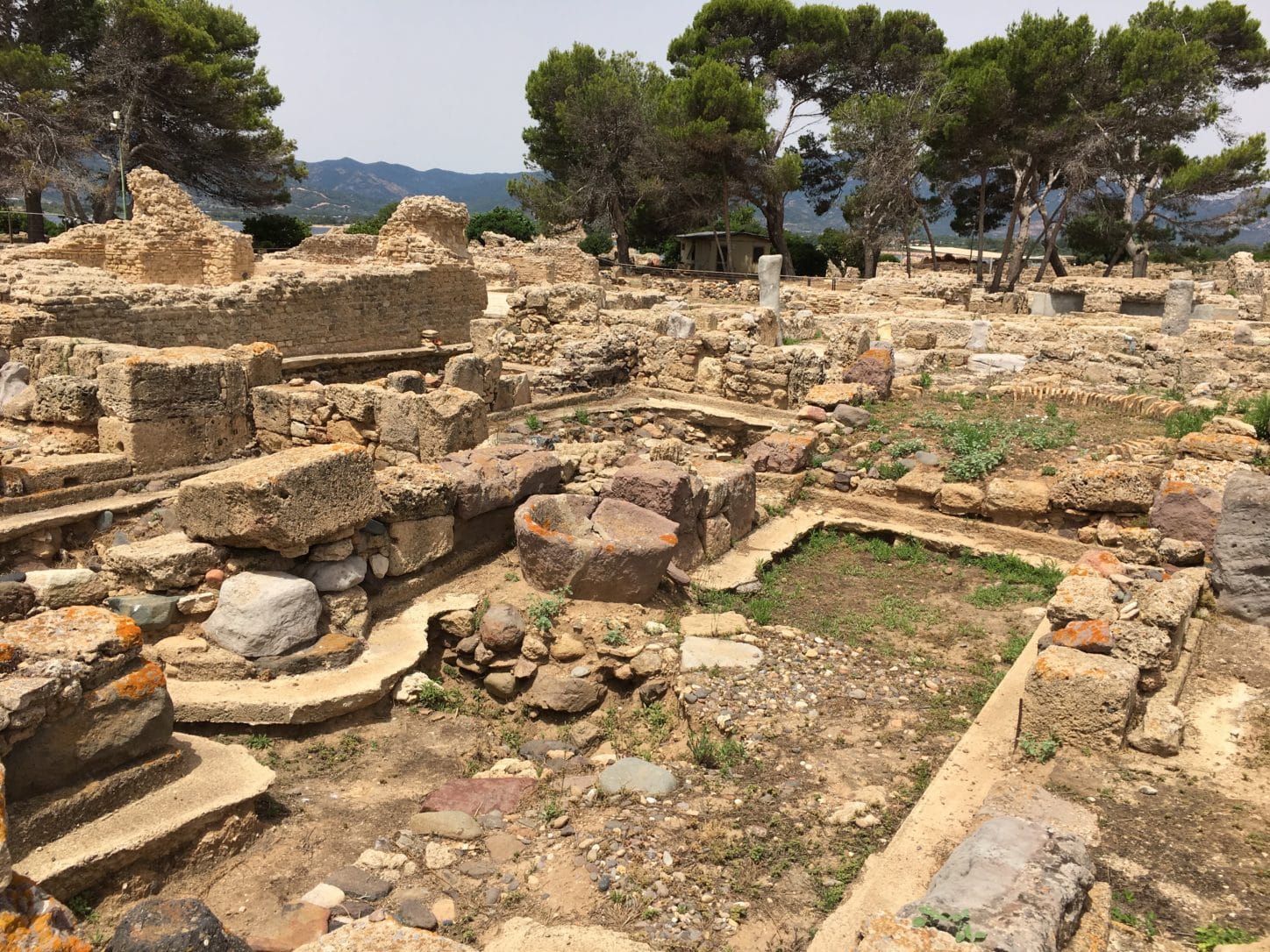
Through the site, we saw chunks of white marble. At one time, Illira told us, the major buildings in the city, like the amphitheater, were sheathed in marble. But over the centuries locals from the surrounding area took what they could cart away to use or sell.
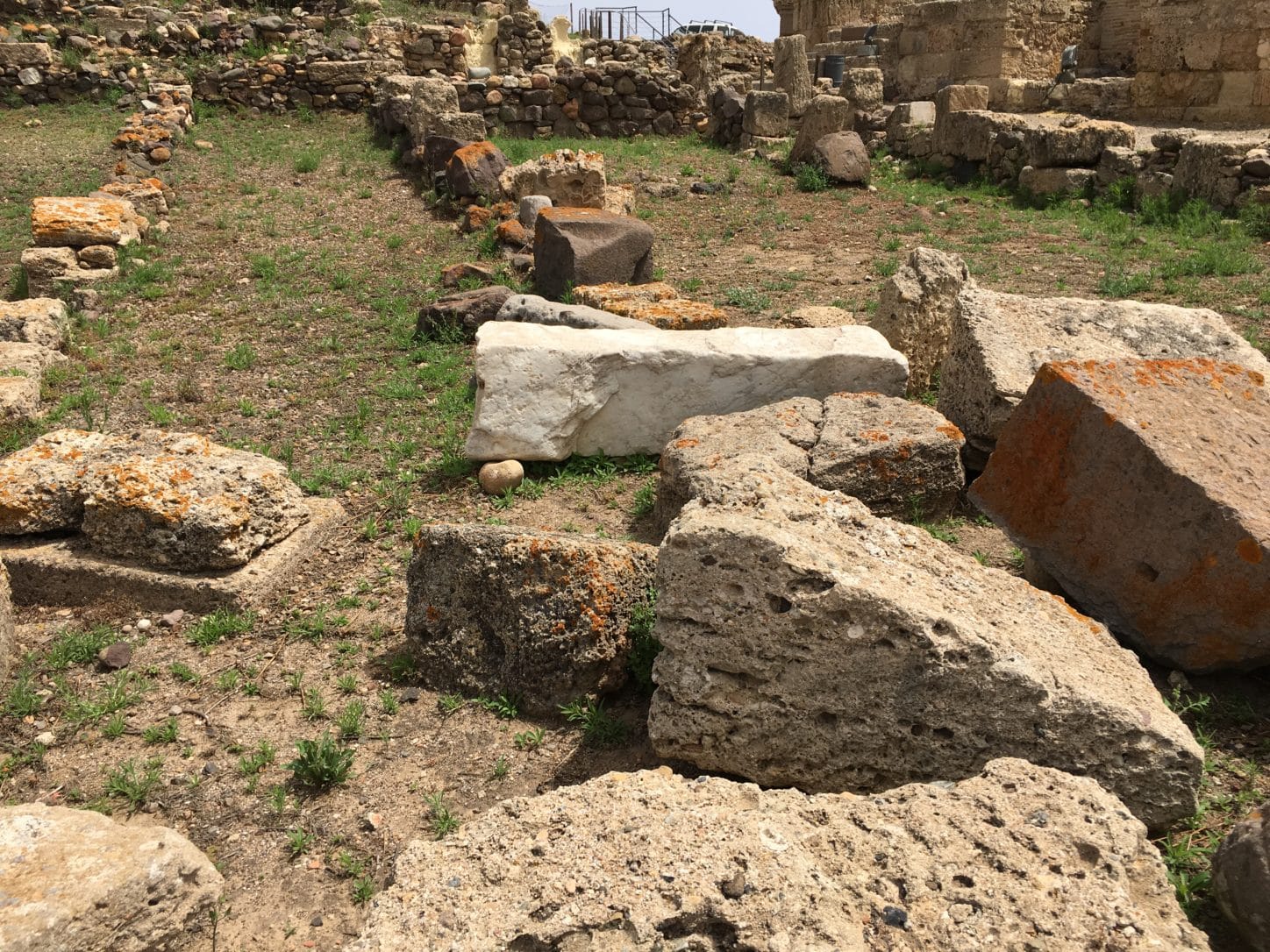
But before the locals, Vandals sacked Nora in the 5th century A.D. and sent the city into a decline. Today the archeologists hold sway, and continue working on the site to gain new insights.
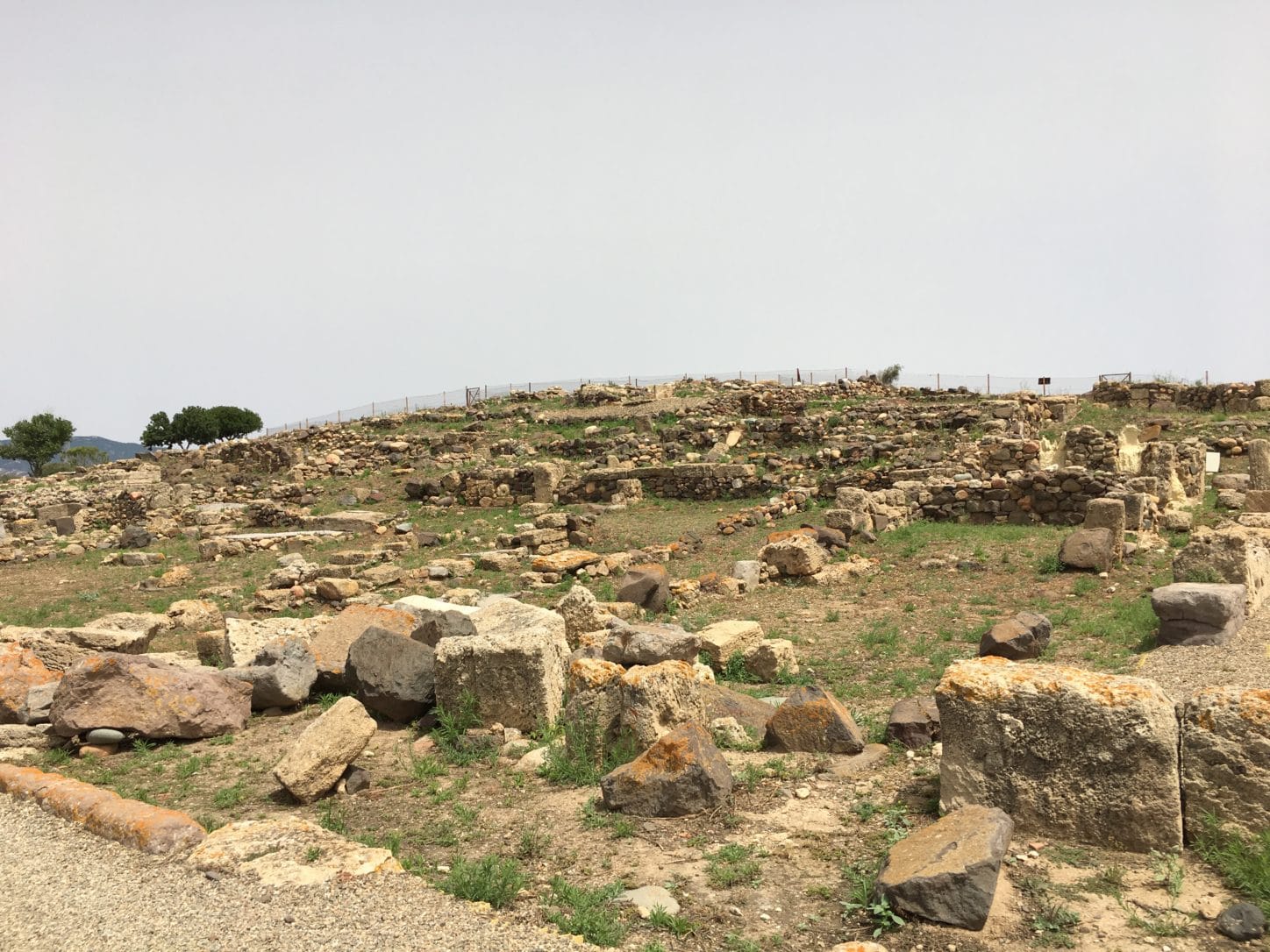
Leaving the tumbled stone and marble remnants, we followed a curved path to the rocky promontory where 18th century Spanish conquerers erected a squat tower.
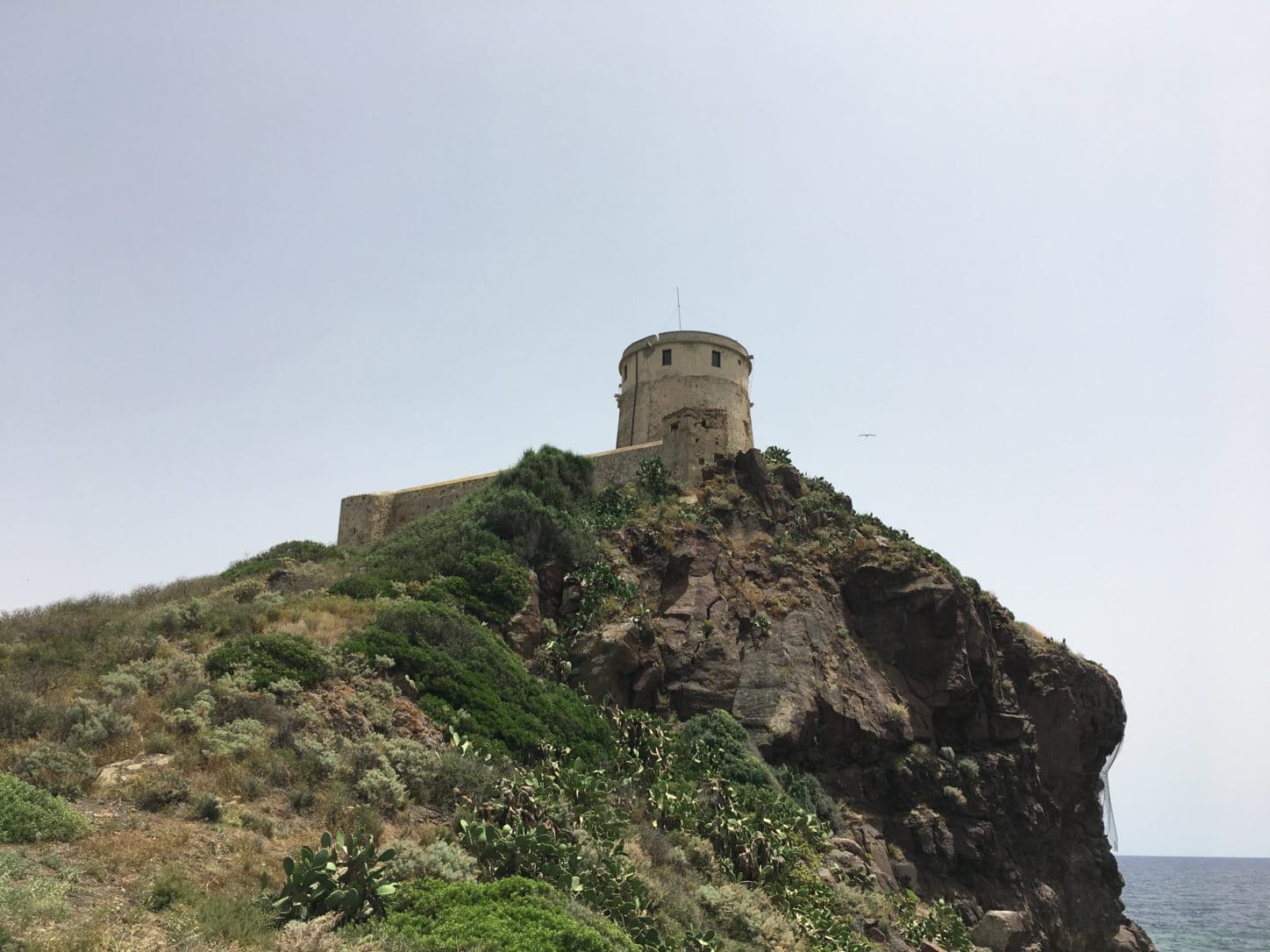
Now used as a lighthouse, it was one of dozens where the coastal guardians lit fires to warn others of dangerous weather or attacking forces.
We punctuated this ancient history lesson with one of the wild goose chases that enrich our holidays with rueful laughs. We had seen online an agroturismo — an Italian invention to lure tourists to the countryside for local food and sometimes rooms — outside Pula that looked like a good spot for lunch.
Sparse and unclear signs directed us in circles. On one rutted dirt road we saw a sign to a local tomba di gigante, which we might have visited if we’d realized we didn’t really see a tomb at Dorgali.
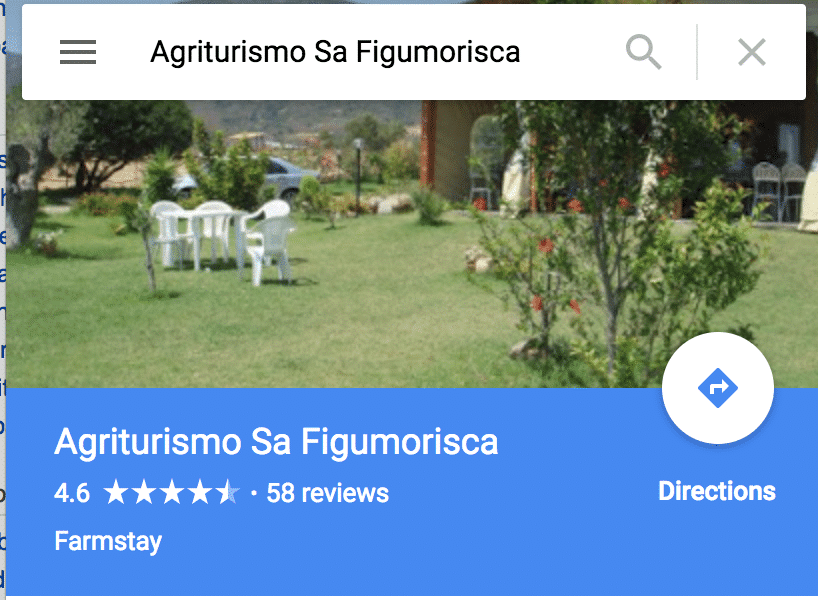
When we did find the agroturismo, it looked abandoned, farm buildings without a car in sight. Later, we received a text from the owner saying they served lunch on Sunday, not Saturday.
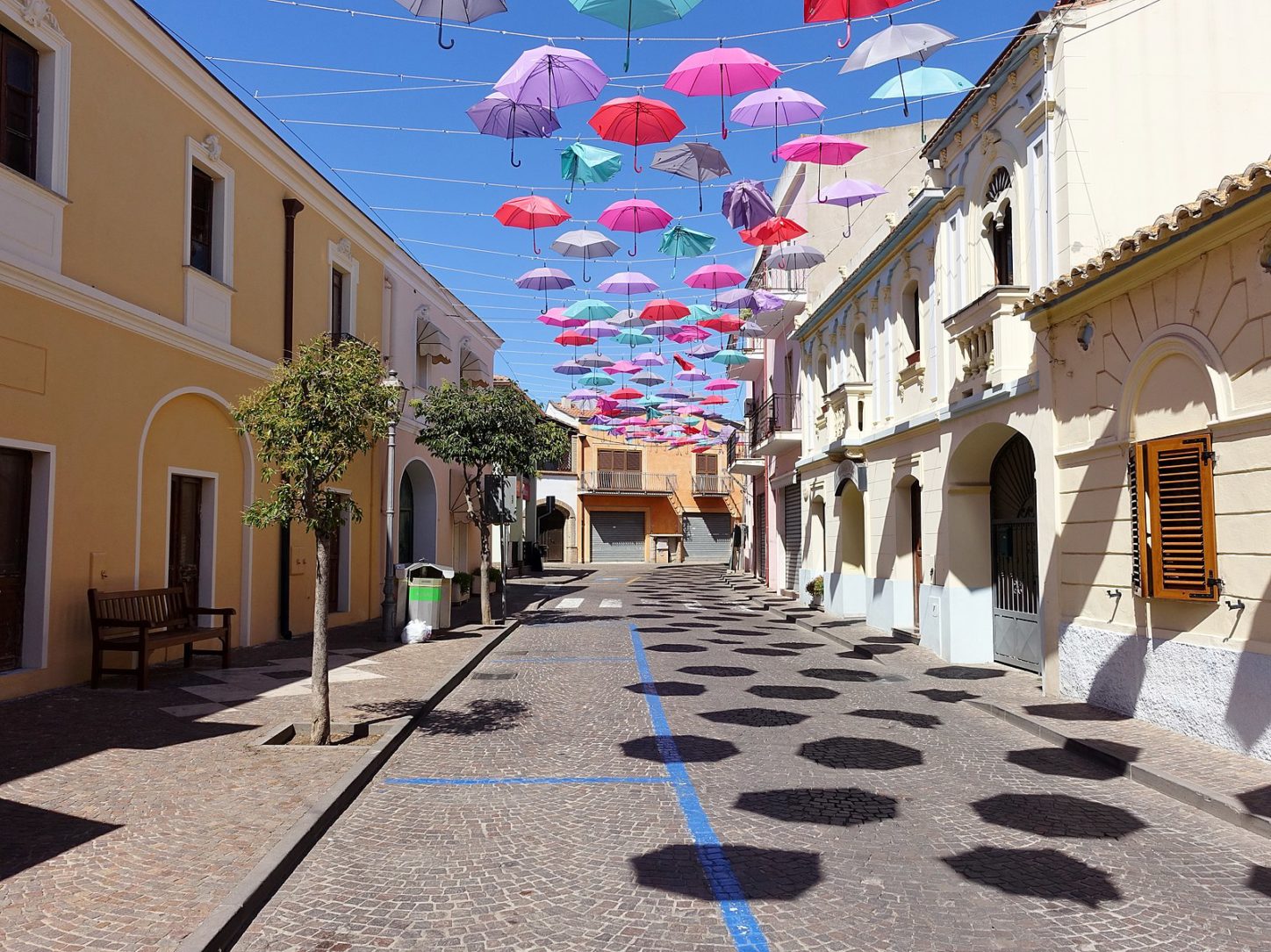
Pula proved attractive, though. We strolled the streets radiating out from the old town’s central square and then returned to the hotel and the salt water infinity pool, and the sea view to relax the afternoon away.

We learned that if you want to go to a restaurant in a small town in Sardinia, you had better make a reservation in advance. We had booked the night before at Zia (Aunty) Leunora after we read that locals liked it a lot.
We also ordered a taxi to take us into Pula so that we could enjoy the Sardinian wine without worrying. We’d never have found Zia Leunora on our own because it was buried deep in Pula’s old town.
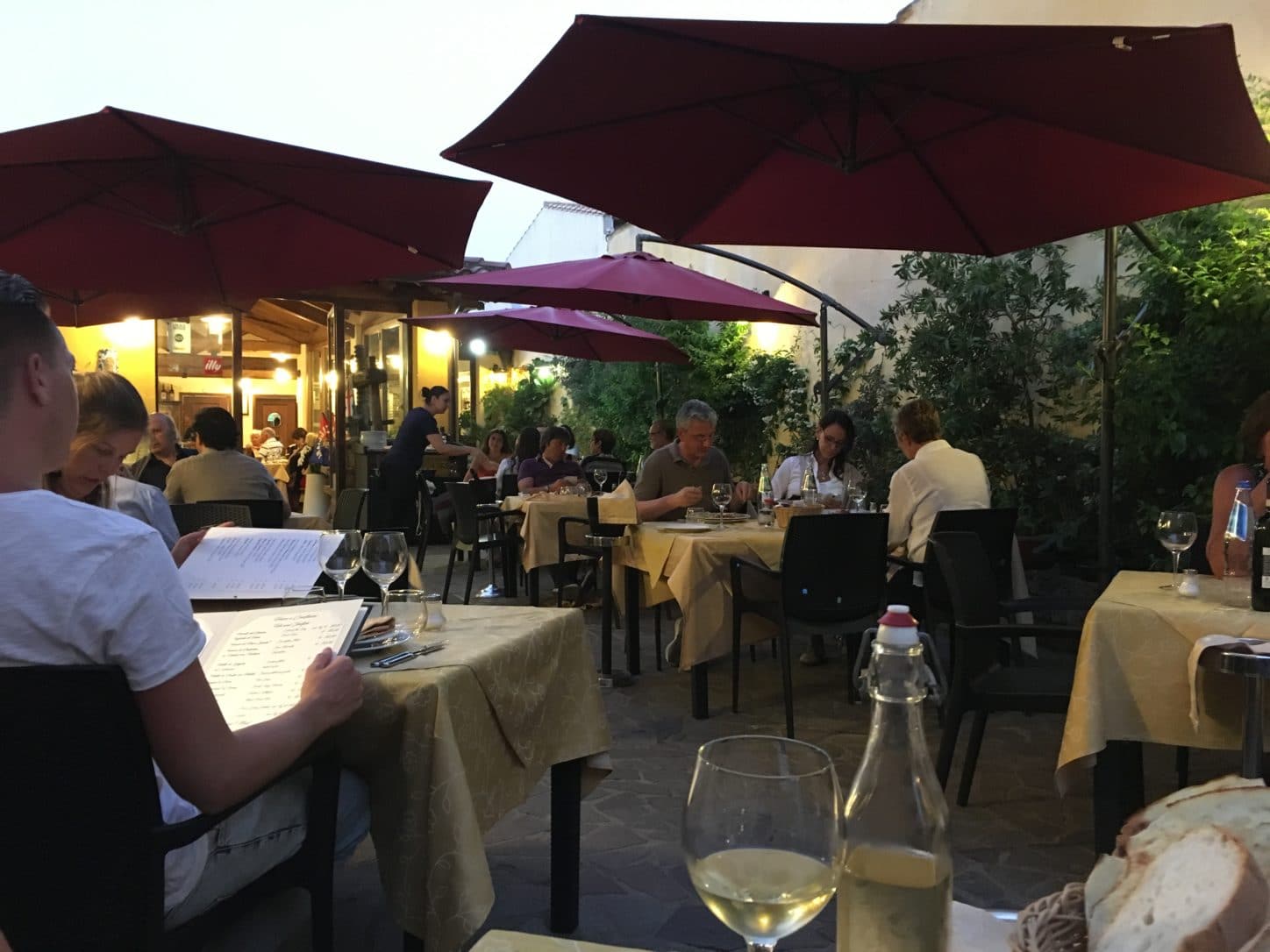
On yet another balmy night, we took a seat outside where we could see patrons coming and going. Most were locals — couples on a date, families eating together. A Dutch couple sat across from us and we started talking.
Like many Europeans, they were mystified about why Americans elected Donald Trump. They approached the topic gingerly at first while they figured out where we stood, then unloaded. They particularly disliked the Dutch-American Tea Party Republican Pete Hoekstra, Trump’s ambassador to the Netherlands, who was caught out by the Dutch press denying he’d said things he was recorded saying. On the plus side they, like us, loved Sardinia, and planned to return.
Our Sardinian restaurant education had included learning to order single courses split between the two of us. This night we did three: sweet and sour sardines,
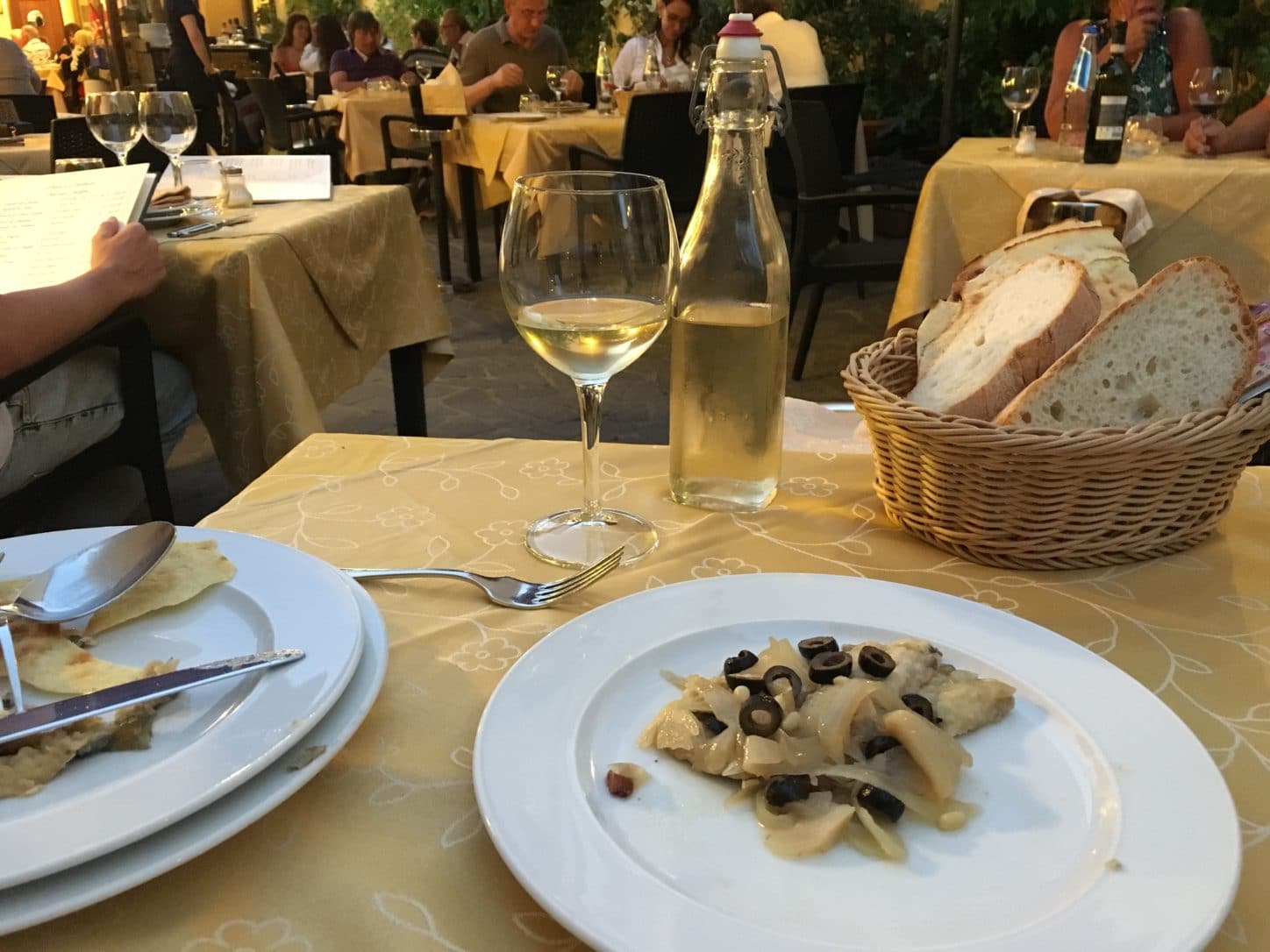
and tagliatelle with bottarga, zucchini, clams and cherry tomatoes, and the main course – sea bass baked in foil with clams, mussels and shrimp.


And of course the house Vermentino, which made us glad to see our taxi driver waiting when we were ready to head back to the hotel.
Sunday morning came all too soon. We packed the Renault, which had served us so well, and took off for the Cagliari airport and our flight to Rome for a two-day stay. And then a near-disaster. We pulled into a parking space in the Hertz section and unloaded the car. Nick tossed the electronic key onto the dashboard, closed the door and went to hand the attendant the car papers,

Seconds later, Barbara heard a “thunk!” as the lights flashed and the car locked itself. A moment of panic until we confirmed that we’d unloaded everything, and then a sigh of sweet relief.

But wait! The horrified attendants yanked unsuccessfully at the door handle until we thought it would come off. One of them said, “You’ll have to wait until someone comes from Cagliari with a key.”
“Why?” Nick asked. “The tank’s full, there are no issues with the car, and you can email me the final paperwork. We have a plane to catch.”
Over his protests, we grabbed our bags. As we pulled them toward the terminal and our flight to Rome, we wondered what if the same thing had happened on some remote mountain road with no cell phone service, the high mountain, bandit town of Orgosolo, for example, several hours drive from Cagliari. We’d remember Sardinia for a long time. The beautiful island and its welcoming people had given us an adventure and an education, but we’d been pretty lucky, too.
